Paul van Yperen's Blog, page 401
November 8, 2014
Happy Birthday, Alain Delon!
Today is the 79th birthday of Alain Delon (1935). The French film star was a breathtakingly good-looking parasite in the sun drenched thriller Plein soleil/Purple Noon (René Clément, 1960). The 'male Brigitte Bardot' proved to be a magnificent actor in masterpieces as Rocco e i suoi fratelli/Rocco and His Brothers (Luchino Visconti, 1960) and L'Eclisse/The Eclipse (Michelangelo Antonioni, 1962). Unforgettable was his part as the calm, psychopathic hoodlum in Le Samouraï/The Godson (Jean-Pierre Melville, 1967), staring into the camera like a cat assessing a mouse. Bon anniversaire, monsieur Delon!
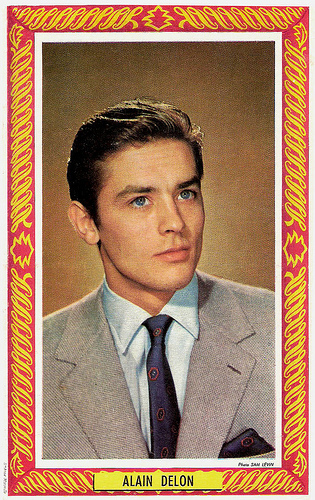
French postcard by St. Anne, Marseille. Photo: Sam Lévin.
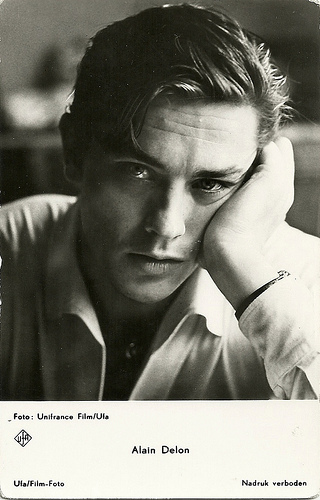
Dutch postcard by Gebr. Spanjersberg, Rotterdam, no. 1383. Photo: Unifrance Film / Ufa.
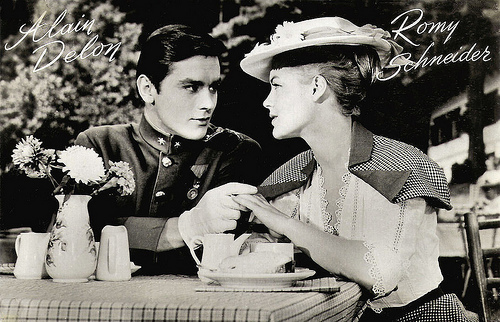
Dutch postcard by Uitg. Takken / 't Sticht, Utrecht, no. 3918. Photo: N.V. Meteor Film / Speva / Play Art Prod. Publicity still for Christine (Pierre Gaspard-Huit, 1958) with Romy Schneider.
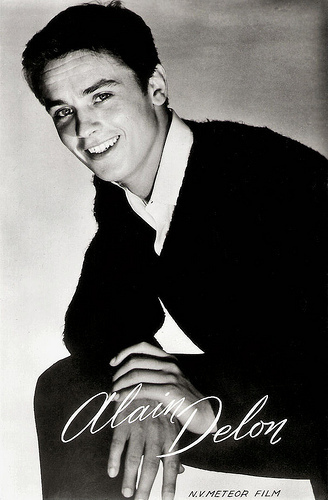
Dutch postcard, no. AX 3981. Photo: Sam Lévin / Speva / Play Art Prod / Meteor Film. Publicity still for Christine (Pierre Gaspard-Huit, 1958).
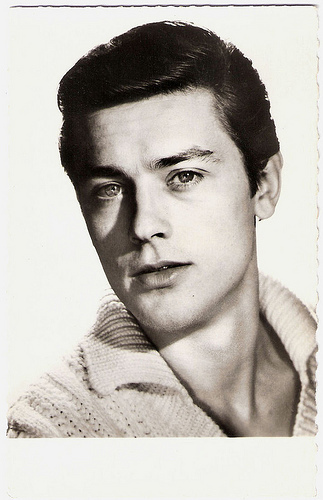
French postcard by Editions P.I., no. 1004. Offered by Les Carbones Korès 'Carboplane'. Photo: Sam Lévin.
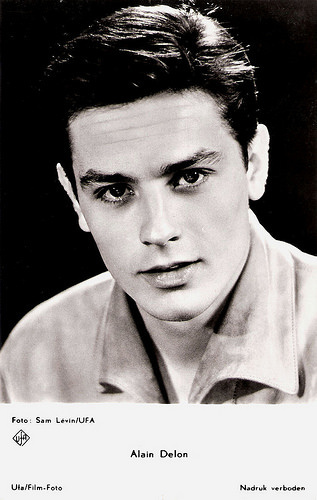
Dutch postcard by Gebr. Spanjersberg, Rotterdam, no. 1252. Photo: Sam Lévin / Ufa.
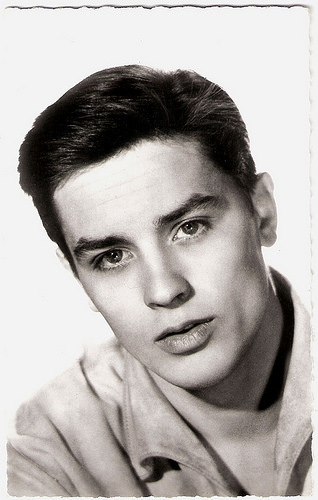
French postcard by Editions du Globe, no. 852. Photo: Sam Lévin.
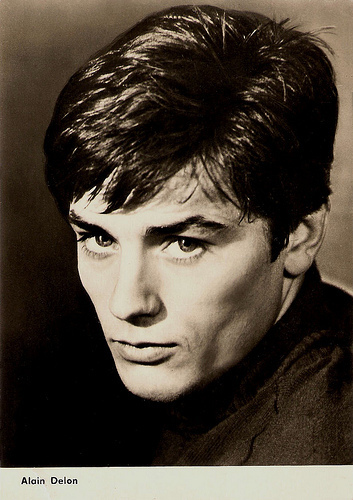
East-German postcard by VEB Progress Film-Vertrieb, Berlin, 1967. retail price: 0,20 MDN.Photo: publicity still for Rocco e i suoi fratelli/Rocco and his brothers (Luchino Visconti, 1960).
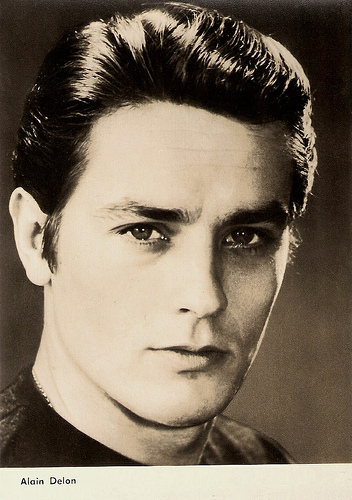
East-German postcard by VEB Progress Film-Vertrieb, Berlin, no. 2529, 1965. retail price: 0,20 MDN.
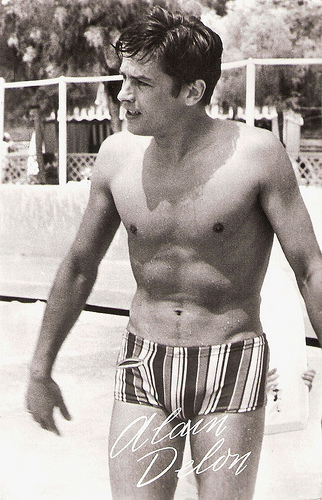
Dutch postcard by 't Sticht, Utrecht, no. 6176.
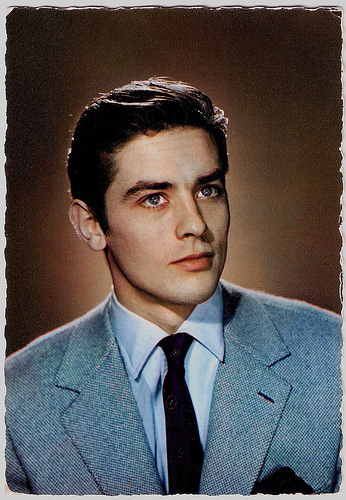
French postcard by Mexichrome, no. 13. Photo: Sam Lévin.
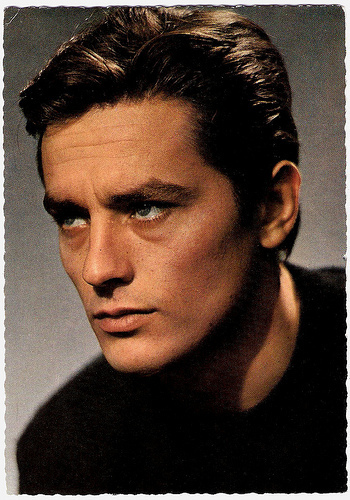
French postcard by E.D.U.G., no. 469. Photo: Sam Lévin.
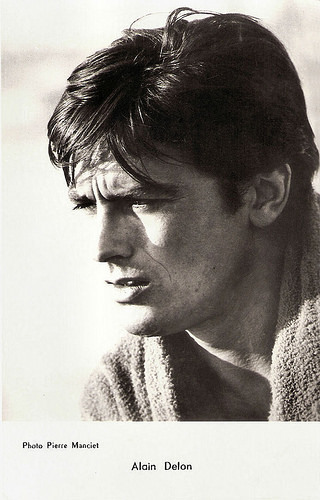
French postcard by Editions P.I., no. 1161, offered by Les Carbones Korès 'Carboplane. Photo: Pierre Manciet.
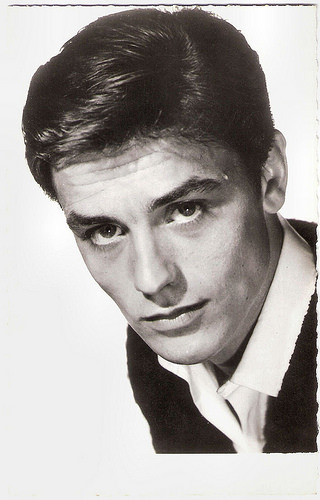
French postcard by Editions P.I., no. 936, offered by Les Carbones Korès 'Carboplane. Photo: Sam Lévin.
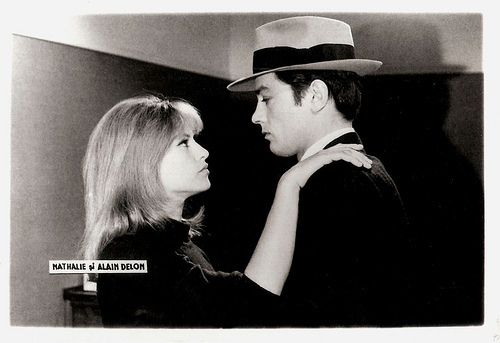
Small Romanian collectors card. Photo: publicity still for Le Samouraï (Jean-Pierre Melville, 1967).
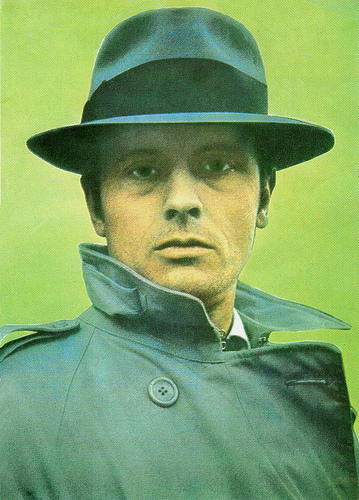
Romanian postcard by Casa Filmului Acin.
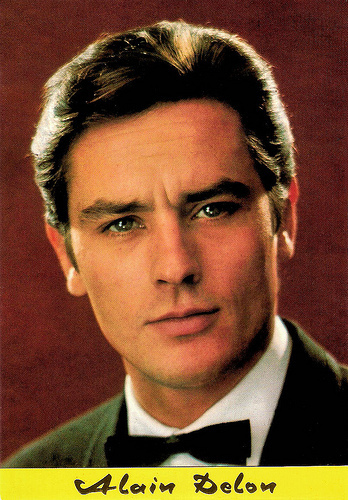
Spanish postcard by Bergas Ind. Graf., Barcelona, no. 463, 1967.
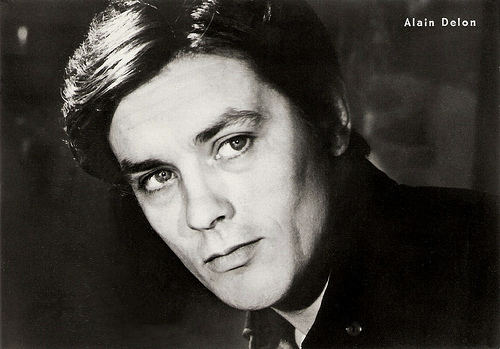
East-German postcard by VEB Progress Film-Vertrieb, Berlin, no. 60/77, 1977. retail price: 0,20 M.
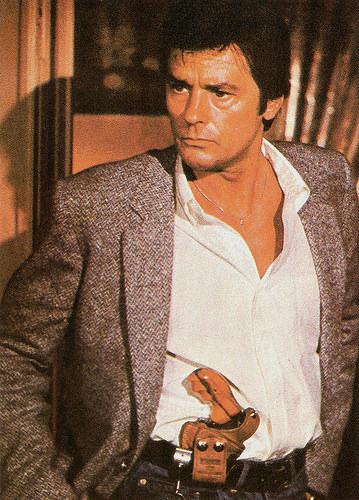
French postcard by Editions F. Nugeron, no. STAR 40.

French postcard by Editions P.I., Paris, no. 3453. Photo: Michel Ginfray.
Wanna more? Join the birthday bash at the Alain Delon group at Flickr.

French postcard by St. Anne, Marseille. Photo: Sam Lévin.

Dutch postcard by Gebr. Spanjersberg, Rotterdam, no. 1383. Photo: Unifrance Film / Ufa.

Dutch postcard by Uitg. Takken / 't Sticht, Utrecht, no. 3918. Photo: N.V. Meteor Film / Speva / Play Art Prod. Publicity still for Christine (Pierre Gaspard-Huit, 1958) with Romy Schneider.

Dutch postcard, no. AX 3981. Photo: Sam Lévin / Speva / Play Art Prod / Meteor Film. Publicity still for Christine (Pierre Gaspard-Huit, 1958).

French postcard by Editions P.I., no. 1004. Offered by Les Carbones Korès 'Carboplane'. Photo: Sam Lévin.

Dutch postcard by Gebr. Spanjersberg, Rotterdam, no. 1252. Photo: Sam Lévin / Ufa.

French postcard by Editions du Globe, no. 852. Photo: Sam Lévin.

East-German postcard by VEB Progress Film-Vertrieb, Berlin, 1967. retail price: 0,20 MDN.Photo: publicity still for Rocco e i suoi fratelli/Rocco and his brothers (Luchino Visconti, 1960).

East-German postcard by VEB Progress Film-Vertrieb, Berlin, no. 2529, 1965. retail price: 0,20 MDN.

Dutch postcard by 't Sticht, Utrecht, no. 6176.

French postcard by Mexichrome, no. 13. Photo: Sam Lévin.

French postcard by E.D.U.G., no. 469. Photo: Sam Lévin.

French postcard by Editions P.I., no. 1161, offered by Les Carbones Korès 'Carboplane. Photo: Pierre Manciet.

French postcard by Editions P.I., no. 936, offered by Les Carbones Korès 'Carboplane. Photo: Sam Lévin.

Small Romanian collectors card. Photo: publicity still for Le Samouraï (Jean-Pierre Melville, 1967).

Romanian postcard by Casa Filmului Acin.

Spanish postcard by Bergas Ind. Graf., Barcelona, no. 463, 1967.

East-German postcard by VEB Progress Film-Vertrieb, Berlin, no. 60/77, 1977. retail price: 0,20 M.

French postcard by Editions F. Nugeron, no. STAR 40.

French postcard by Editions P.I., Paris, no. 3453. Photo: Michel Ginfray.
Wanna more? Join the birthday bash at the Alain Delon group at Flickr.
Published on November 08, 2014 06:00
November 7, 2014
Angélique (1964-1968)
Today's film special is about a typical European phenomenon: Angélique. The feisty heroin of the romantic adventure novels by Anne and Serge Colon was the subject of five popular films of the 1960s. Michèle Mercier played the 'Marquise of the Angels', and she was surrounded by a dozen of hunky co-stars, including Giuliano Gemma, Jean-Louis Trintignant, Samy Frey, Jean-Claude Pascal and of course Robert Hossein as Angélique's husband, the scarred Joffrey De Peyrac.
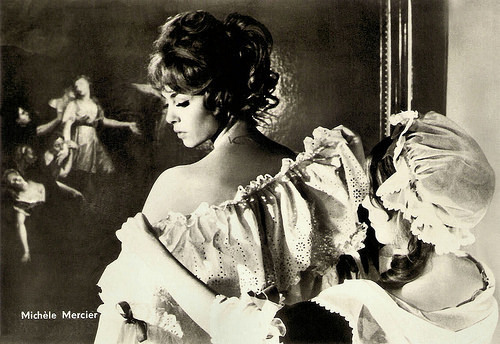
Michèle Mercier . East-German postcard by VEB Progress Film-Vertrieb, Berlin, no. 25/71, 1971. Retail price: 0,20 DM. Photo: Progress.
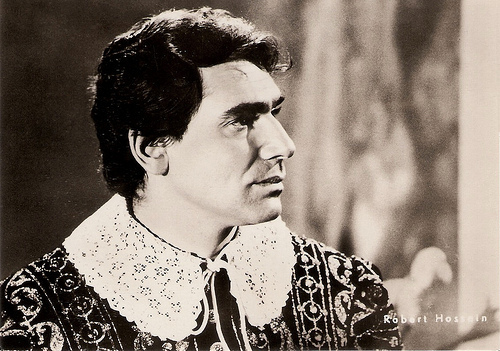
Robert Hossein . East-German postcard by VEB Progress Film-Vertrieb, Berlin, no. 32/71. Retail price: 0,20 M.
An Overnight Success
The Angélique phenomenon started as a series of 13 French historical adventure books by Anne and Serge Golon. In fact, Anne Golon is the author and her husband Serge did much of the historical research.
The first novel, Angélique, the Marquise of the Angels, was published in 1957. The book was an overnight success.
Heroin Angélique de Sancé de Monteloup is a lusciously beautiful 17th Century woman, fifth child of an impoverished country nobleman in the Poitou marshlands in the west of France.
Wikipedia gives a bit ironic summary of the successive books: "she marries at a young age the romantic and talented Count of Toulouse; gets her domestic bliss destroyed when King Louis XIV has her husband executed on trumped up charges; descends into the underworld of Paris; emerges and through a turbulent second marriage gets admittance to the court in Versailles; loses her second husband in war, just as she had started to truly love him, and subsequently refuses to become the King's mistress; finds that her first husband is after all alive and is hiding somewhere in the Mediterranean; sets out on a highly risky search, gets captured by pirates, sold into slavery in Crete, taken into the harem of the King of Morocco, stabs the King when he tries to have sex with her, and stages a daring escape" etc.
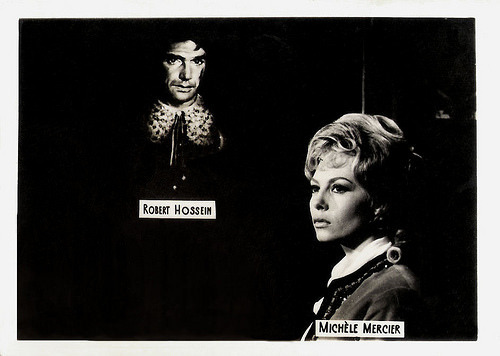
Robert Hossein , Michèle Mercier . Romanian mini-card.
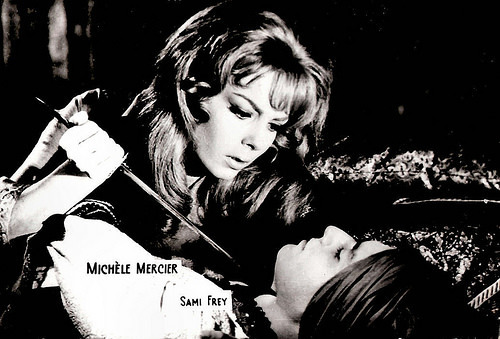
Small Romanian collectors card. Photo: publicity still for Angélique et le roy/Angelique and the King (Bernard Borderie, 1966) with Michèle Mercier and Samy Frey .
Unique flair for historical costume dramas
Some of the Angélique novels were adapted into a series of 5 popular films:
Angélique, Marquise des Anges/Angélique (1964).Merveilleuse Angelique/Angelique: The Road to Versailles (1965).Angélique et le roy/Angelique and the King (1966).Indomptable Angelique/Untamable Angelique (1967).Angélique et le sultan/Angelique and the Sultan (1968).
According to James Travers at French Film Site, Angélique, Marquise des Anges/Angélique is notably the best of the series: "the adventures of a beautiful 17th century marquise, Angélique, played magnificently by Michèle Mercier . Although rarely seen outside of continental Europe, these films were very successful in France in the 1960s and display that country's unique flair for historical costume dramas."
The films were a joint production of France, Italy and Germany. Director of the whole series of films was Bernard Borderie and the main stars were Michèle Mercier as Angélique Sancé de Monteloup and Robert Hossein as Jeoffrey de Peyrac.
Other characters were played by Jean Rochefort as Desgrez, Giuliano Gemma as Angelique's childhood friend Nicolas Merlot, Jacques Toja as King Louis XIV, Claude Giraud as Angélique's second husband Philippe de Plessis-Bellières, Jean-Louis Trintignant as the poet Claude le Petit, Samy Frey as Bachtiary Bey, Estella Blain as the evil Madame De Montespan, Fred Williams as Ràkóczi, and in the final film Jean-Claude Pascal as Sultan Osman Ferradji.
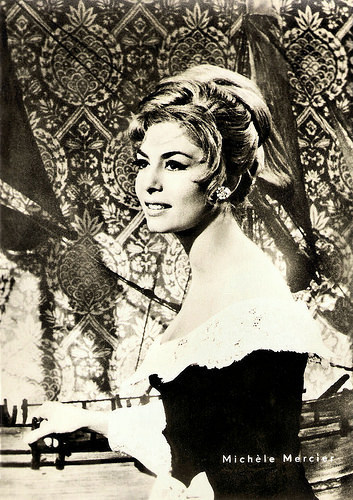
Michèle Mercier . East-German postcard by VEB Progress Film-Vertrieb, Berlin, no. 35/71, 1971. Retail price: 0,20 DM. Photo: Progress.

Romanian postcard by Casa Filmului Acin. Publicity still for Indomptable Angelique/Untamable Angelique (Bernard Borderie, 1967) with Robert Hossein .
New Hope
The first 10 books have been adapted into English while numbers 11-13 have not. For those English readers, who have waited over thirty-five years to read the conclusion of the Angélique series, there is new hope.
According to Wikipedia , Anne Golon has announced that she will re-publish the Angélique books, restoring the lacunae missing from her original manuscripts because of professional editing.
She plans to title this version L'Integrale (complete works). Anne Golon explained that there is much material that has never been published and which will tie into two later, and still unwritten, books in the series.
These two books will follow the original series: Royaume de France (Kingdom of France), and a fifteenth and final volume, as yet untitled, to complete the series.
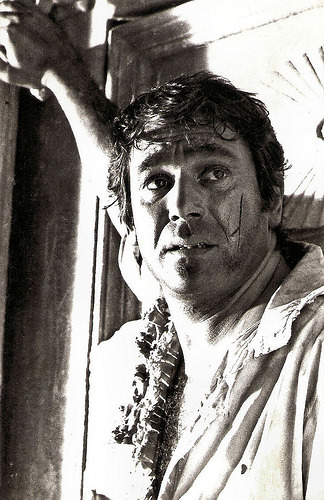
Romanian postcard by Casa Filmului Acin, no. 277. Photo: publicity still for Angelique et le sultan/Angelique and the Sultan (Bernard Borderie, 1968) with Robert Hossein .
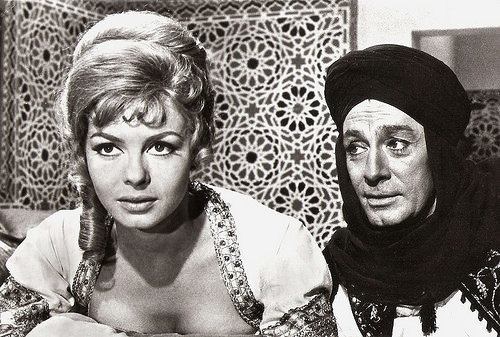
Romanian postcard by Casa Filmului Acin. Photo: publicity still for Angelique et le sultan/Angelique and the sultan (Bernard Borderie, 1968) with Michèle Mercier and Jean-Claude Pascal .
A Turkish Angélique
The Angélique films were popular all over Europe. They were also very popular in Central Europe where the postcards used for this post were published, by Progress in East-Germany and by Acin in Romania.
During the 1970s, all the kids at my school were exited to see the Angélique films when they were shown on Dutch television. Romance, adventure, and a tiny bit of nudity. We loved it.
To my surprise, two Turkish Angélique films exist as well: Anjelik Osmanli saraylarinda/Angélique in the Ottoman Palaces (Ülkü Erakalin, 1967) and Anjelik ve Deli Ibrahim/Angelique and Deli Ibrahim (Süha Dogan, 1968), both starring Sevda Ferdag as Anjelik 'Angélique de Peyrac'. The first film gets a 7,9 rating at IMDb .
In 2013, a remake of Angélique, marquise des anges went in premiere: Angélique (Ariel Zeitoun, 2013). Nora Arnezeder played Angelique and Gérard Lanvin Joffrey de Peyrac.
At IMDb , the film received a poor rating of only 5,6, but Polish reviewer Malgga liked it 'very, very much': "A beautiful, engaging and immensely romantic rendition of the 'Beauty and the Beast' fairy tale motive".
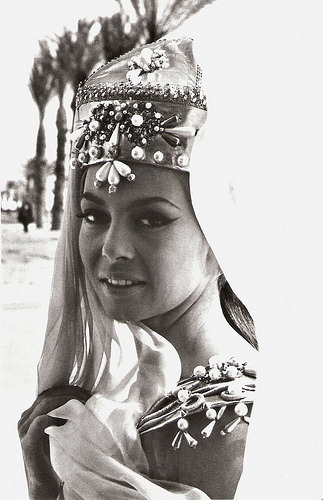
Romanian postcard by Casa Filmului Acin. Photo: publicity still for Angelique et le sultan/Angelique and the sultan (Bernard Borderie, 1968) with Michèle Mercier .
Sources: James Travers (French Film Site), Wikipedia and .

Michèle Mercier . East-German postcard by VEB Progress Film-Vertrieb, Berlin, no. 25/71, 1971. Retail price: 0,20 DM. Photo: Progress.

Robert Hossein . East-German postcard by VEB Progress Film-Vertrieb, Berlin, no. 32/71. Retail price: 0,20 M.
An Overnight Success
The Angélique phenomenon started as a series of 13 French historical adventure books by Anne and Serge Golon. In fact, Anne Golon is the author and her husband Serge did much of the historical research.
The first novel, Angélique, the Marquise of the Angels, was published in 1957. The book was an overnight success.
Heroin Angélique de Sancé de Monteloup is a lusciously beautiful 17th Century woman, fifth child of an impoverished country nobleman in the Poitou marshlands in the west of France.
Wikipedia gives a bit ironic summary of the successive books: "she marries at a young age the romantic and talented Count of Toulouse; gets her domestic bliss destroyed when King Louis XIV has her husband executed on trumped up charges; descends into the underworld of Paris; emerges and through a turbulent second marriage gets admittance to the court in Versailles; loses her second husband in war, just as she had started to truly love him, and subsequently refuses to become the King's mistress; finds that her first husband is after all alive and is hiding somewhere in the Mediterranean; sets out on a highly risky search, gets captured by pirates, sold into slavery in Crete, taken into the harem of the King of Morocco, stabs the King when he tries to have sex with her, and stages a daring escape" etc.

Robert Hossein , Michèle Mercier . Romanian mini-card.

Small Romanian collectors card. Photo: publicity still for Angélique et le roy/Angelique and the King (Bernard Borderie, 1966) with Michèle Mercier and Samy Frey .
Unique flair for historical costume dramas
Some of the Angélique novels were adapted into a series of 5 popular films:
Angélique, Marquise des Anges/Angélique (1964).Merveilleuse Angelique/Angelique: The Road to Versailles (1965).Angélique et le roy/Angelique and the King (1966).Indomptable Angelique/Untamable Angelique (1967).Angélique et le sultan/Angelique and the Sultan (1968).
According to James Travers at French Film Site, Angélique, Marquise des Anges/Angélique is notably the best of the series: "the adventures of a beautiful 17th century marquise, Angélique, played magnificently by Michèle Mercier . Although rarely seen outside of continental Europe, these films were very successful in France in the 1960s and display that country's unique flair for historical costume dramas."
The films were a joint production of France, Italy and Germany. Director of the whole series of films was Bernard Borderie and the main stars were Michèle Mercier as Angélique Sancé de Monteloup and Robert Hossein as Jeoffrey de Peyrac.
Other characters were played by Jean Rochefort as Desgrez, Giuliano Gemma as Angelique's childhood friend Nicolas Merlot, Jacques Toja as King Louis XIV, Claude Giraud as Angélique's second husband Philippe de Plessis-Bellières, Jean-Louis Trintignant as the poet Claude le Petit, Samy Frey as Bachtiary Bey, Estella Blain as the evil Madame De Montespan, Fred Williams as Ràkóczi, and in the final film Jean-Claude Pascal as Sultan Osman Ferradji.

Michèle Mercier . East-German postcard by VEB Progress Film-Vertrieb, Berlin, no. 35/71, 1971. Retail price: 0,20 DM. Photo: Progress.

Romanian postcard by Casa Filmului Acin. Publicity still for Indomptable Angelique/Untamable Angelique (Bernard Borderie, 1967) with Robert Hossein .
New Hope
The first 10 books have been adapted into English while numbers 11-13 have not. For those English readers, who have waited over thirty-five years to read the conclusion of the Angélique series, there is new hope.
According to Wikipedia , Anne Golon has announced that she will re-publish the Angélique books, restoring the lacunae missing from her original manuscripts because of professional editing.
She plans to title this version L'Integrale (complete works). Anne Golon explained that there is much material that has never been published and which will tie into two later, and still unwritten, books in the series.
These two books will follow the original series: Royaume de France (Kingdom of France), and a fifteenth and final volume, as yet untitled, to complete the series.

Romanian postcard by Casa Filmului Acin, no. 277. Photo: publicity still for Angelique et le sultan/Angelique and the Sultan (Bernard Borderie, 1968) with Robert Hossein .

Romanian postcard by Casa Filmului Acin. Photo: publicity still for Angelique et le sultan/Angelique and the sultan (Bernard Borderie, 1968) with Michèle Mercier and Jean-Claude Pascal .
A Turkish Angélique
The Angélique films were popular all over Europe. They were also very popular in Central Europe where the postcards used for this post were published, by Progress in East-Germany and by Acin in Romania.
During the 1970s, all the kids at my school were exited to see the Angélique films when they were shown on Dutch television. Romance, adventure, and a tiny bit of nudity. We loved it.
To my surprise, two Turkish Angélique films exist as well: Anjelik Osmanli saraylarinda/Angélique in the Ottoman Palaces (Ülkü Erakalin, 1967) and Anjelik ve Deli Ibrahim/Angelique and Deli Ibrahim (Süha Dogan, 1968), both starring Sevda Ferdag as Anjelik 'Angélique de Peyrac'. The first film gets a 7,9 rating at IMDb .
In 2013, a remake of Angélique, marquise des anges went in premiere: Angélique (Ariel Zeitoun, 2013). Nora Arnezeder played Angelique and Gérard Lanvin Joffrey de Peyrac.
At IMDb , the film received a poor rating of only 5,6, but Polish reviewer Malgga liked it 'very, very much': "A beautiful, engaging and immensely romantic rendition of the 'Beauty and the Beast' fairy tale motive".

Romanian postcard by Casa Filmului Acin. Photo: publicity still for Angelique et le sultan/Angelique and the sultan (Bernard Borderie, 1968) with Michèle Mercier .
Sources: James Travers (French Film Site), Wikipedia and .
Published on November 07, 2014 22:00
November 6, 2014
Carmen Cartellieri
Beautiful silent film actress Carmen Cartellieri (1891-1953) was a star of many Austrian dramas and melodramas of the early 1920s.
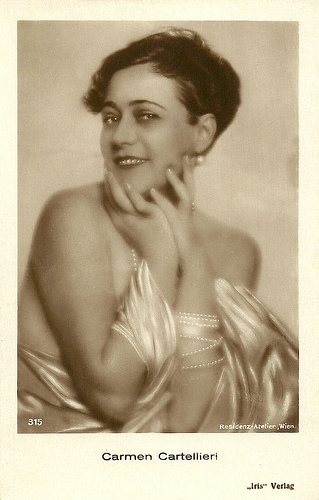
Austrian postcard by Iris Verlag, no. 315. Photo: Residenz-Atelier, Vienna.
Kill Her!
Carmen Cartellieri was born as Franziska Ottilia Cartellieri in Prossnitz, Austria-Hungary (now Prostejov, Czech Republic) in 1891. She was the daughter of an engineer and grew up in Innsbruck and other places.
At the age of 16 she got married to chemist, painter, inventor and for a while film director Mano Ziffer-Teschenbruk, and in the early 1910s their daughter was born.
Carmen stayed a hausfrau till 1918, when Tyrolean director and script writer Cornelius Hintner discovered her by accident. He offered her a part in the Hungarian film Az összeesküvök/The conspirators (Emil Justitz, 1919), for which he had written the script.
After her six more Hungarian films under the stage name Carmen Teschen, the political situation caused her to move from Budapest to Vienna. There she appeared in Hintner's Anjula, das Zigeunermädchen/Anjula, the Gypsy Girl (Cornelius Hintner, 1919) and Die Würghand/The Strangling Hand (Cornelius Hintner, 1920).
The Viennese public liked her and she was chosen as 'the most beautiful actress of Vienna'. Next she starred in Carmen lernt Schifahren/Carmen Learns To Ski (Mano Ziffer-Teschenbruk, 1920), directed by her husband and produced by her own newly established film company.
For Cartellieri-Film, the actress subsequently played in Der weisse Tod/The White Death (1921), Das Drama in den Dolomiten/The Tragedy in the Dolomites (Cornelius Hintner, 1921), Parema - Das Wesen aus der Sternenwelt/Parema, Creature from the Starworld (Mano Ziffer-Teschenbruk, 1922), Die gelbe Gefahr/The Yellow Danger (1922), and Die Sünde der Inge Lars/The Sin of Inge Lars (Mano Ziffer-Teschenbruk, 1922).
In the meantime she also played in one German film shot in Berlin, Büsse der Leidenschaft (Paul von Woringen, 1920), as well as in the Austrian production Der tote Hochzeitsgast/The Dead Wedding Guest (1921) by Max Neufeld, a film director with whom she would frequently collaborate.
After Cartellieri-Film stopped, Cartellieri continued to work at other minor Austrian companies: Töte sie!/Kill Her! (Cornelius Hintner, 1922), Die Sportlady/The Sporting Lady (Cornelius Hintner, 1922), Die Menschen nennen es Liebe/People Call It Love (Mano Ziffer-Teschenbruk, 1922) with Fred Louis Lerch , Die Frauen des Harry Bricourt/The Wives of Harry Bricourt (Richard Arvay, 1922) starring Anton Tiller, Eines Vaters Söhne/Son of a Father (Paul Garbagni, 1923) with Olaf Fjord , Fiat Lux (Wilhelm Thiele, 1923) opposite Hella Moja , Was ist Liebe...?/What is Love...? (Leopold Niernberger, 1924), Die Geheimnis der Schrift/The secret of the Writing (Dezsö Kertész, 1924) with Erika Glässner , and Die Tragödie einer Frau/The Tragedy of a Woman (Dezsö Kertész, 1924) with Max Landa .
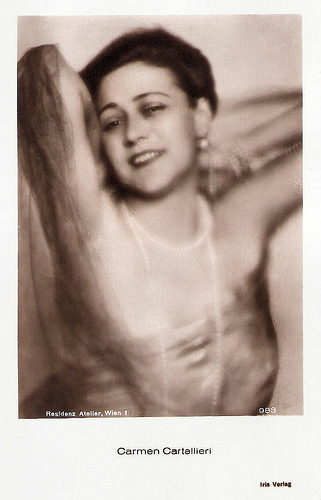
Austrian postcard by Iris Verlag, no. 989. Photo: Residenz Atelier, Wien.
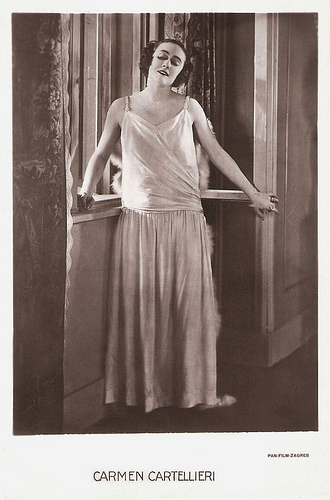
Yugoslavian postcard by Jos. Caklovic, Zagreb, no. 26. Photo: Pan-Film, Zagreb.
The Hands of Orlac
In 1924 Carmen Cartellieri played in the expresionistic horror classic Orlacs Hande/The Hands of Orlac by reputed director Robert Wiene. Conrad Veidt featured as a famous pianist whose hands have been replaced by those of a murderer.
The Austrian-German coproduction was shot in Vienna, but for Cartellieri it did not result in a one way ticket to Babelsberg. She basically remained in Vienna to act in Austrian films, until the end of the silent era.
Sometimes she worked with renowned directors such as Max Neufeld in Der Balletherzog (1926) co-starring Werner Pittschau , and again with Wiene in Der Rosenkavalier/The Knight Of The Rose (1925), based on the opera by Richard Strauss and written by Hugo von Hofmannsthal, the opera's librettist.
During the 1920s she also worked in the theatre. She often appeared at the Ronacher theater in Vienna, but she was also seen in the 1926 Pantomime Der Todesring (The Ring of Death).
Cartellieri acted in a handful of films in Munich for the Emelka company, such as Die Hölle von Montmartre/The Hell of Montmartre (Willy Reiber, Frans Seitz, 1927), where she played oposite Suzy Vernon , and she made one more film in Berlin, Madame wagt einen Seitensprung/Madame Ventures an Affair (Hans Otto Löwenstein, 1927) with Xenia Desni .
Then the era of the silent cinema was over and so was Cartellieri's film career. But she retired with a bang, while her ler last appearance was a plum role in the Mayerling drama Das Schicksal derer von Habsburg/The Destiny of the Von Habsburgs (1928).
Little is known about her later life. Carmen Cartellieri died in Vienna in 1953.
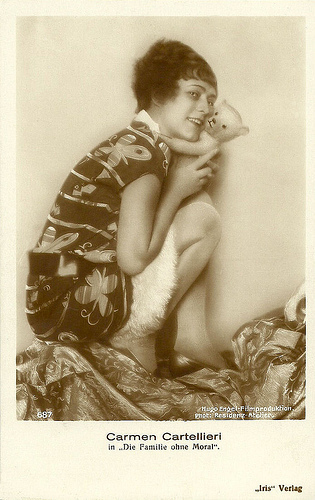
Austrian postcard by Iris Verlag, no. 687. Photo: Residenz-Atelier / Hugo Engel-Filmproduktion. Publicity still for Die Familie ohne Moral/The family without morals (Max Neufeld, 1927). Collection: Didier Hanson.
DVD trailer of Orlacs Hände/The Hands of Orlac (Robert Wiene, 1924). Source: Kino International (YouTube).
Sources: Thomas Staedeli (Cyranos), Wikipedia (German), and .

Austrian postcard by Iris Verlag, no. 315. Photo: Residenz-Atelier, Vienna.
Kill Her!
Carmen Cartellieri was born as Franziska Ottilia Cartellieri in Prossnitz, Austria-Hungary (now Prostejov, Czech Republic) in 1891. She was the daughter of an engineer and grew up in Innsbruck and other places.
At the age of 16 she got married to chemist, painter, inventor and for a while film director Mano Ziffer-Teschenbruk, and in the early 1910s their daughter was born.
Carmen stayed a hausfrau till 1918, when Tyrolean director and script writer Cornelius Hintner discovered her by accident. He offered her a part in the Hungarian film Az összeesküvök/The conspirators (Emil Justitz, 1919), for which he had written the script.
After her six more Hungarian films under the stage name Carmen Teschen, the political situation caused her to move from Budapest to Vienna. There she appeared in Hintner's Anjula, das Zigeunermädchen/Anjula, the Gypsy Girl (Cornelius Hintner, 1919) and Die Würghand/The Strangling Hand (Cornelius Hintner, 1920).
The Viennese public liked her and she was chosen as 'the most beautiful actress of Vienna'. Next she starred in Carmen lernt Schifahren/Carmen Learns To Ski (Mano Ziffer-Teschenbruk, 1920), directed by her husband and produced by her own newly established film company.
For Cartellieri-Film, the actress subsequently played in Der weisse Tod/The White Death (1921), Das Drama in den Dolomiten/The Tragedy in the Dolomites (Cornelius Hintner, 1921), Parema - Das Wesen aus der Sternenwelt/Parema, Creature from the Starworld (Mano Ziffer-Teschenbruk, 1922), Die gelbe Gefahr/The Yellow Danger (1922), and Die Sünde der Inge Lars/The Sin of Inge Lars (Mano Ziffer-Teschenbruk, 1922).
In the meantime she also played in one German film shot in Berlin, Büsse der Leidenschaft (Paul von Woringen, 1920), as well as in the Austrian production Der tote Hochzeitsgast/The Dead Wedding Guest (1921) by Max Neufeld, a film director with whom she would frequently collaborate.
After Cartellieri-Film stopped, Cartellieri continued to work at other minor Austrian companies: Töte sie!/Kill Her! (Cornelius Hintner, 1922), Die Sportlady/The Sporting Lady (Cornelius Hintner, 1922), Die Menschen nennen es Liebe/People Call It Love (Mano Ziffer-Teschenbruk, 1922) with Fred Louis Lerch , Die Frauen des Harry Bricourt/The Wives of Harry Bricourt (Richard Arvay, 1922) starring Anton Tiller, Eines Vaters Söhne/Son of a Father (Paul Garbagni, 1923) with Olaf Fjord , Fiat Lux (Wilhelm Thiele, 1923) opposite Hella Moja , Was ist Liebe...?/What is Love...? (Leopold Niernberger, 1924), Die Geheimnis der Schrift/The secret of the Writing (Dezsö Kertész, 1924) with Erika Glässner , and Die Tragödie einer Frau/The Tragedy of a Woman (Dezsö Kertész, 1924) with Max Landa .

Austrian postcard by Iris Verlag, no. 989. Photo: Residenz Atelier, Wien.

Yugoslavian postcard by Jos. Caklovic, Zagreb, no. 26. Photo: Pan-Film, Zagreb.
The Hands of Orlac
In 1924 Carmen Cartellieri played in the expresionistic horror classic Orlacs Hande/The Hands of Orlac by reputed director Robert Wiene. Conrad Veidt featured as a famous pianist whose hands have been replaced by those of a murderer.
The Austrian-German coproduction was shot in Vienna, but for Cartellieri it did not result in a one way ticket to Babelsberg. She basically remained in Vienna to act in Austrian films, until the end of the silent era.
Sometimes she worked with renowned directors such as Max Neufeld in Der Balletherzog (1926) co-starring Werner Pittschau , and again with Wiene in Der Rosenkavalier/The Knight Of The Rose (1925), based on the opera by Richard Strauss and written by Hugo von Hofmannsthal, the opera's librettist.
During the 1920s she also worked in the theatre. She often appeared at the Ronacher theater in Vienna, but she was also seen in the 1926 Pantomime Der Todesring (The Ring of Death).
Cartellieri acted in a handful of films in Munich for the Emelka company, such as Die Hölle von Montmartre/The Hell of Montmartre (Willy Reiber, Frans Seitz, 1927), where she played oposite Suzy Vernon , and she made one more film in Berlin, Madame wagt einen Seitensprung/Madame Ventures an Affair (Hans Otto Löwenstein, 1927) with Xenia Desni .
Then the era of the silent cinema was over and so was Cartellieri's film career. But she retired with a bang, while her ler last appearance was a plum role in the Mayerling drama Das Schicksal derer von Habsburg/The Destiny of the Von Habsburgs (1928).
Little is known about her later life. Carmen Cartellieri died in Vienna in 1953.

Austrian postcard by Iris Verlag, no. 687. Photo: Residenz-Atelier / Hugo Engel-Filmproduktion. Publicity still for Die Familie ohne Moral/The family without morals (Max Neufeld, 1927). Collection: Didier Hanson.
DVD trailer of Orlacs Hände/The Hands of Orlac (Robert Wiene, 1924). Source: Kino International (YouTube).
Sources: Thomas Staedeli (Cyranos), Wikipedia (German), and .
Published on November 06, 2014 23:00
November 5, 2014
Stacia Napierkowska
The exotic French actress and dancer Stacia Napierkowska (1886-1945) was a fascinating star of the silent film era. Between 1908 and 1926 she appeared in 86 films, and is best remembered as the seductive but cruel Queen Antinéa in the classic fantasy L’Atlantide/Missing Husbands (1921).

French postcard in the series Les Vedettes de Cinéma by A.N., Paris, no. 50. Photo: Sobol.
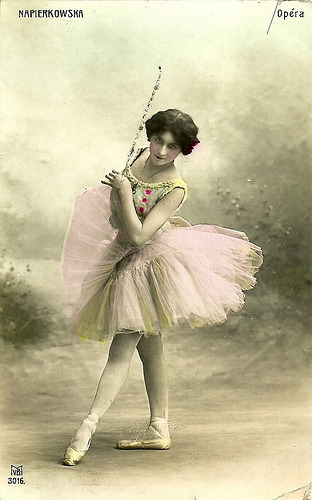
French postcard by MvB, no. 3016. Mailed in 1908.
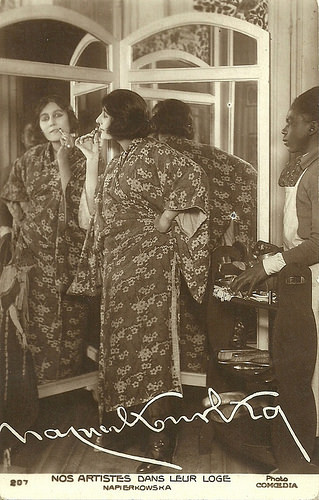
French postcard in the series Nos artistes dans leur loge, no. 207. Photo: Comoedia.
Indescribable Enthusiasm
Stacia Napierkowska was born Renée Claire Angèle Élisabeth Napierkowski in Paris, France, in 1886 (some sources say 1891; and in the magazine Mon Ciné (no. 17, 1922) she even declared to be born in 1896). Her parents were Polish.
Like Mistinguett , she debuted as a dancer in the revues of the Folies-Bergère. Then she danced in a revival of Lysistrata by Maurice Donnay at the Bouffes-Parisiens. Albert Carré director of the Opéra Comique spotted her and engaged her for the production Fêtes Romaines (Roman Holiday), which he presented at the Théâtre Antique d'Orange.
Her performance, but especially her statuesque body and her beauty, triggered an indescribable enthusiasm from thousands of spectators. The public’s fascination for her would endure for twenty years.
In 1908, when she was already a star dancer at the Opéra Comique, Napierkowska made her film debut in L'empreinte ou la main rouge/The mark or The Red Hand (Paul Henri Burguet, 1908) with Max Dearly and Mistinguett . Philippe Pelletier at Ciné Artistes writes that “her perfect physique, her long black hair and dark eyes were quickly put to use to interpret exotic roles for productions of the Société Cinématographique des Auteurs et Gens de Lettres (Film Society of Authors and Men of Letters) directed by Albert Capellani”.
Here she often inserted dances into her performances as in Dans l'Hellade/In Hellas (Charles Decroix, 1909), Cléopâtre/Cleopatra (Ferdinand Zecca, Henri Andréani, 1910) where she is a messenger who is poisoned and dances a dance of death, and Le pain des petits oiseaux/The Bread of Little Birds (Albert Capellani, 1911), in which she becomes a dance star.
Several internet sources like Philippe Pelletier at Ciné-Artistes state that Stacia performed Queen Semiramis in Le sérail en dix volets/Sémiramis (Camille Morlhon, 1910), but that is incorrect - existing film copies show that the role was played by Yvonne Mirval. Stacia instead was a very voluptuous - and again dancing - Esmeralda in an early silent adaptation of Victor Hugo’s Notre-Dame de Paris/ The Hunchback of Notre Dame (Albert Capellani, 1911), opposite Henry Krauss as Quasimodo.
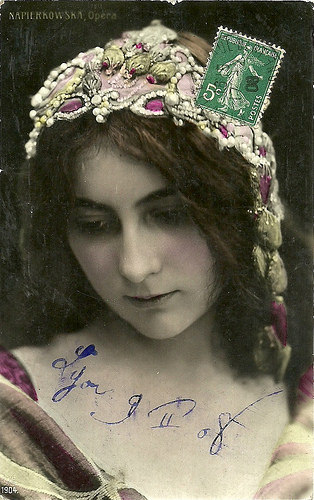
French postcard, 1904. Mailed in 1908.
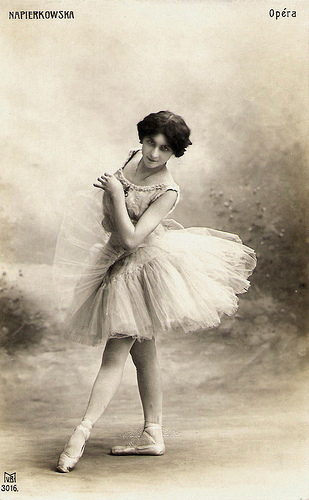
French postcard by MvB, no. 3016.
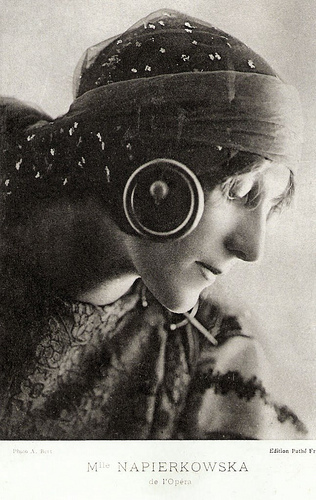
French postcard by Pathé Frères. Photo: A. Bert.
American Censors
Max Linder , always looking for pretty women, engaged Stacia Napierkowska as his partner in several short comedies like Max lance la mode/Max Sets the Fashion (René Leprince, Max Linder, 1912). In Spain she did a dance tour and appeared in the film Max toréador (Max Linder, 1913).
Stacia Napierkowska then set course to the United States with The Captive. This ballet captured the American public, but not the censors. In 1913, she was arrested during a performance in New York City which was declared indecent. After returning to France, Napierkowska stated in the New York Times (27 April 1913): "Really, I have not brought away a single pleasant memory from the United States" and "What a narrow-minded people they are -- how utterly impervious to any beautiful impression!"
In France her successful film career continued. She appeared as Marfa Koutiloff in the popular serial Les Vampires/The Vampires (Louis Feuillade, 1915) starring the equally exotic Musidora .
Then she went immediately to Rome to star in Lo stratagemma di Stasià/Stacia’s Stratagem (Ugo Falena, 1915) and a score of other Italian short films during the early years of World War I.
In Rome, she tried to convince her close friend, journalist Germaine Dulac, to start making films. Dulac finally agreed on condition that Stacia would participate in her second film, the adventure Venus Victrix/In the storm of life (Germaine Dulac, 1917).
Napierkowska also directed a short silent film herself, L'Héritière de la manade/The Heiress of the Manade (Stacia Napierkowska, 1917). Then she then took a break from the cinema and ballet to rest.
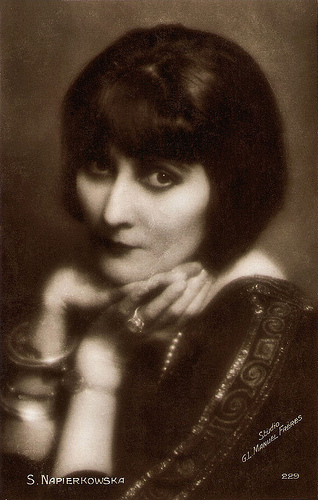
French postcard by Cinémagazine-Edition, Paris, no. 229. Sent by mail in 1928. Photo: Studio G.L. Manuel Frères.
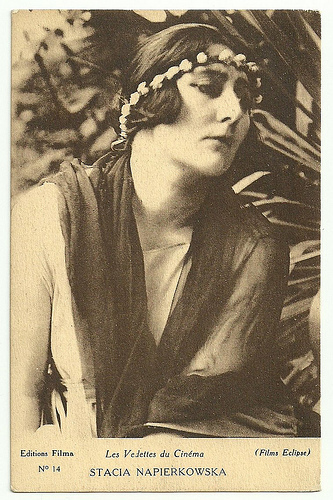
French postcard by Editions Filma in the series Les Vedettes du Cinéma, no. 14. Photo: Films Eclipse.
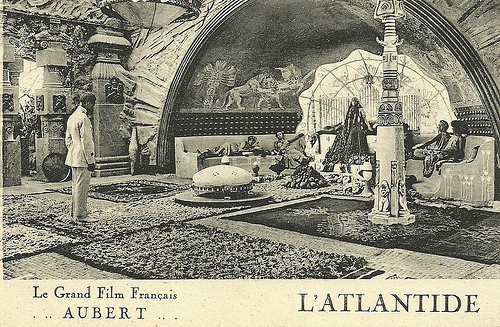
French postcard for the Louis Aubert production L'Atlantide (1921) by Jacques Feyder, based on the novel by Pierre Benoit. The card depicts the French captain Morhange ( Jean Angelo ) received by the mysterious and cruel desert queen Antinéa (Stacia Napierkowska). The sets were by Manuel Orazi.
Queen of Atlantis
Stacia Napierkowska is probably best known for her role as Antinéa, Queen of Atlantis, in the fantasy film L'Atlantide/Missing Husbands (Jacques Feyder, 1921). The director approached her for this part in 1919.
IMDb cites director Jacques Feyder about this meeting: "Miss Napierkowska was an extraordinary dancer. I had seen her at a dance festival where she, as slim as a flower stalk, had been enthusiastically applauded by a crowd of Parisians admirers. A year later, having to choose actors for L'Atlantide, I proposed her for the leading part of Antinéa and the producer agreed; so, in a cold December afternoon, she was in my office, all wrapped in a fur coat, to sign the contract. I thought I did not remember so a plump face but my doubt vanished in a moment because I was too happy for having her in my film, and she left the office without having put off her coat. The first costume rehearsal was an ugly surprise for me: during last year she had gained a thirty pounds of weight at least. Of course there was nothing to do but hoping that a hard work and the burning sun of Sahara could get my Antinéa a little less fat. It happened just the opposite: the air of the desert whetted her appetite more and more. The dresser complained for having to enlarge the costumes almost every day. Our headquarters were at Touggourt, in a hotel where the food was simply delicious, and because of it my most important occupations were to take away as much bread as possible from her table and tell her dreadful tales about the terrible effects of cream pastry when eaten under the tropical sun".
Despite an exuberance of boas, ostrich feathers and leopard skins, the filmmaker struggled to hide the overweight of his Diva during the shooting in 1920. Finally, she would not dance in the film and merely played the vamp with her eyes. However, L'Atlantide/Atlantis became a great success and turned Stacia Napierkowska into one of the legends of the silent cinema.
Napierkowska made a few more films. Her last screen role was Salomé in Le berceau de dieu/The Cradle of God (Fred LeRoy Granville, 1926) starring Léon Mathot . After that she retired. Philippe Pelletier writes that she “then quickly sank into oblivion.”
Stacia Napierkowska died in 1945 in her hometown Paris.
Scene from Les Vampires/The Vampires (1915). Source: cidvale (YouTube).
Scene from L'Atlantide/Missing Husbands (1921). Source: astique 333 (YouTube).
Sources: Philippe Pelletier (Ciné Artistes) (French), Mon Ciné (Virtual History), Wikipedia and .

French postcard in the series Les Vedettes de Cinéma by A.N., Paris, no. 50. Photo: Sobol.

French postcard by MvB, no. 3016. Mailed in 1908.

French postcard in the series Nos artistes dans leur loge, no. 207. Photo: Comoedia.
Indescribable Enthusiasm
Stacia Napierkowska was born Renée Claire Angèle Élisabeth Napierkowski in Paris, France, in 1886 (some sources say 1891; and in the magazine Mon Ciné (no. 17, 1922) she even declared to be born in 1896). Her parents were Polish.
Like Mistinguett , she debuted as a dancer in the revues of the Folies-Bergère. Then she danced in a revival of Lysistrata by Maurice Donnay at the Bouffes-Parisiens. Albert Carré director of the Opéra Comique spotted her and engaged her for the production Fêtes Romaines (Roman Holiday), which he presented at the Théâtre Antique d'Orange.
Her performance, but especially her statuesque body and her beauty, triggered an indescribable enthusiasm from thousands of spectators. The public’s fascination for her would endure for twenty years.
In 1908, when she was already a star dancer at the Opéra Comique, Napierkowska made her film debut in L'empreinte ou la main rouge/The mark or The Red Hand (Paul Henri Burguet, 1908) with Max Dearly and Mistinguett . Philippe Pelletier at Ciné Artistes writes that “her perfect physique, her long black hair and dark eyes were quickly put to use to interpret exotic roles for productions of the Société Cinématographique des Auteurs et Gens de Lettres (Film Society of Authors and Men of Letters) directed by Albert Capellani”.
Here she often inserted dances into her performances as in Dans l'Hellade/In Hellas (Charles Decroix, 1909), Cléopâtre/Cleopatra (Ferdinand Zecca, Henri Andréani, 1910) where she is a messenger who is poisoned and dances a dance of death, and Le pain des petits oiseaux/The Bread of Little Birds (Albert Capellani, 1911), in which she becomes a dance star.
Several internet sources like Philippe Pelletier at Ciné-Artistes state that Stacia performed Queen Semiramis in Le sérail en dix volets/Sémiramis (Camille Morlhon, 1910), but that is incorrect - existing film copies show that the role was played by Yvonne Mirval. Stacia instead was a very voluptuous - and again dancing - Esmeralda in an early silent adaptation of Victor Hugo’s Notre-Dame de Paris/ The Hunchback of Notre Dame (Albert Capellani, 1911), opposite Henry Krauss as Quasimodo.

French postcard, 1904. Mailed in 1908.

French postcard by MvB, no. 3016.

French postcard by Pathé Frères. Photo: A. Bert.
American Censors
Max Linder , always looking for pretty women, engaged Stacia Napierkowska as his partner in several short comedies like Max lance la mode/Max Sets the Fashion (René Leprince, Max Linder, 1912). In Spain she did a dance tour and appeared in the film Max toréador (Max Linder, 1913).
Stacia Napierkowska then set course to the United States with The Captive. This ballet captured the American public, but not the censors. In 1913, she was arrested during a performance in New York City which was declared indecent. After returning to France, Napierkowska stated in the New York Times (27 April 1913): "Really, I have not brought away a single pleasant memory from the United States" and "What a narrow-minded people they are -- how utterly impervious to any beautiful impression!"
In France her successful film career continued. She appeared as Marfa Koutiloff in the popular serial Les Vampires/The Vampires (Louis Feuillade, 1915) starring the equally exotic Musidora .
Then she went immediately to Rome to star in Lo stratagemma di Stasià/Stacia’s Stratagem (Ugo Falena, 1915) and a score of other Italian short films during the early years of World War I.
In Rome, she tried to convince her close friend, journalist Germaine Dulac, to start making films. Dulac finally agreed on condition that Stacia would participate in her second film, the adventure Venus Victrix/In the storm of life (Germaine Dulac, 1917).
Napierkowska also directed a short silent film herself, L'Héritière de la manade/The Heiress of the Manade (Stacia Napierkowska, 1917). Then she then took a break from the cinema and ballet to rest.

French postcard by Cinémagazine-Edition, Paris, no. 229. Sent by mail in 1928. Photo: Studio G.L. Manuel Frères.

French postcard by Editions Filma in the series Les Vedettes du Cinéma, no. 14. Photo: Films Eclipse.

French postcard for the Louis Aubert production L'Atlantide (1921) by Jacques Feyder, based on the novel by Pierre Benoit. The card depicts the French captain Morhange ( Jean Angelo ) received by the mysterious and cruel desert queen Antinéa (Stacia Napierkowska). The sets were by Manuel Orazi.
Queen of Atlantis
Stacia Napierkowska is probably best known for her role as Antinéa, Queen of Atlantis, in the fantasy film L'Atlantide/Missing Husbands (Jacques Feyder, 1921). The director approached her for this part in 1919.
IMDb cites director Jacques Feyder about this meeting: "Miss Napierkowska was an extraordinary dancer. I had seen her at a dance festival where she, as slim as a flower stalk, had been enthusiastically applauded by a crowd of Parisians admirers. A year later, having to choose actors for L'Atlantide, I proposed her for the leading part of Antinéa and the producer agreed; so, in a cold December afternoon, she was in my office, all wrapped in a fur coat, to sign the contract. I thought I did not remember so a plump face but my doubt vanished in a moment because I was too happy for having her in my film, and she left the office without having put off her coat. The first costume rehearsal was an ugly surprise for me: during last year she had gained a thirty pounds of weight at least. Of course there was nothing to do but hoping that a hard work and the burning sun of Sahara could get my Antinéa a little less fat. It happened just the opposite: the air of the desert whetted her appetite more and more. The dresser complained for having to enlarge the costumes almost every day. Our headquarters were at Touggourt, in a hotel where the food was simply delicious, and because of it my most important occupations were to take away as much bread as possible from her table and tell her dreadful tales about the terrible effects of cream pastry when eaten under the tropical sun".
Despite an exuberance of boas, ostrich feathers and leopard skins, the filmmaker struggled to hide the overweight of his Diva during the shooting in 1920. Finally, she would not dance in the film and merely played the vamp with her eyes. However, L'Atlantide/Atlantis became a great success and turned Stacia Napierkowska into one of the legends of the silent cinema.
Napierkowska made a few more films. Her last screen role was Salomé in Le berceau de dieu/The Cradle of God (Fred LeRoy Granville, 1926) starring Léon Mathot . After that she retired. Philippe Pelletier writes that she “then quickly sank into oblivion.”
Stacia Napierkowska died in 1945 in her hometown Paris.
Scene from Les Vampires/The Vampires (1915). Source: cidvale (YouTube).
Scene from L'Atlantide/Missing Husbands (1921). Source: astique 333 (YouTube).
Sources: Philippe Pelletier (Ciné Artistes) (French), Mon Ciné (Virtual History), Wikipedia and .
Published on November 05, 2014 22:00
November 4, 2014
Véra Clouzot
Brazilian born French actress and screenwriter Véra Clouzot (1913-1960) only appeared in three films. Despite her very short career, she starred in such unforgettable classics as Le Salaire de la Peur/The Wages of Fear (1953) and Les Diaboliques/Diabolique (1955). All her films were directed by her husband, French master of suspense Henri-Georges Clouzot.
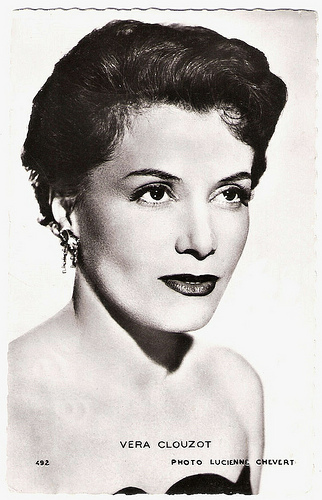
French postcard by Editions P.I., Paris, no. 492. Photo: Lucienne Chevert.
Coup de Foudre
Véra (also Vera) Clouzot was born as Véra Gibson-Amado in Rio de Janeiro, Brazil, in 1913.
She was the daughter of one of Brazil's most notorious political figures, Gilberto Amado. Amado was a congressman, writer, journalist and lawyer, and the ex-President of the United Nations' International Law Committee. In 1915, he shot to death fellow writer and poet Aníbal Teóphilo in an official ceremony at the Jornal do Commercio for disagreeing with his opinions on literature. Amado was acquitted.
His daughter met in 1941 the French actor Léo Lapara. He was a member of the theatre company of Louis Jouvet , which happened to be on tour in Rio de Janeiro. They married shortly after and she then joined the company for a tour in South America that lasted for nearly four years.
After the Second World War they returned to France and Vera settled in Paris. Louis Jouvet took over the direction of the Theatre Athenée and he continued to give Véra small roles.
In 1947, Lapara played a role in the film Quai des Orfevres/Quay of the Goldsmiths (Henri-Georges Clouzot, 1947). When Véra met the director on the set it was a ‘coup de foudre’: love at first sight. Clouzot hired her as a script girl for his next film Miquette et sa mere/Miquette (Henri-Georges Clouzot, 1949) starring Louis Jouvet . Vera divorced Lapara, and in 1950 she married Clouzot.
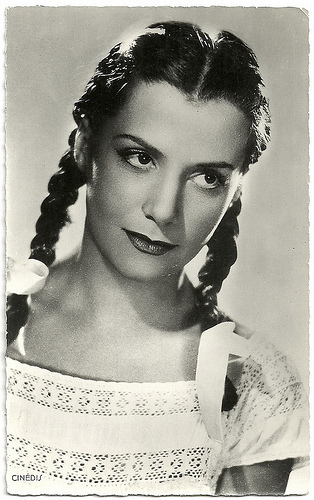
French postcard by Cinédis. Clouzot is coiffed as her character in Le Salaire de la Peur/The Wages of Fear (Henri-Georges Clouzot, 1953).
The French Hitchcock
Véra Clouzot would play the female lead in her husband's next film, Le Salaire de la Peur/The Wages of Fear (Henri-Georges Clouzot, 1953).
Her co-stars in this magnificent thriller (#166 in IMDb ’s Top 250) were Charles Vanel and Yves Montand . They played Frenchmen stranded in South-America, who are hired to transport an urgent nitro-glycerine shipment without the equipment that would make it safe.
Véra Clouzot did her own stunts in the film, which included getting on a moving truck and being pushed away to the ground.
IMDb reviewer Dennis Littrell writes about her performance: “Véra Clouzot plays Linda who first appears scrubbing the floor in an open-air bistro. She is rather extraordinary herself, finely made up and creamy white like a star of the silent film era. She grovels a lot, especially for Mario (Montand). She provides the counter-point, the contrast for the testosterone action of the movie.”
At AllMovie , Hal Erickson adds about the film: “The first half of the film slowly, methodically introduces the characters and their motivations. The second half -- the drive itself -- is a relentless, goosebump-inducing assault on the audience's senses.”
Le Salaire de la Peur was the winner of the Grand Prix at the Cannes Festival and made Henri-Georges Clouzot known as ‘the French Hitchcock’.
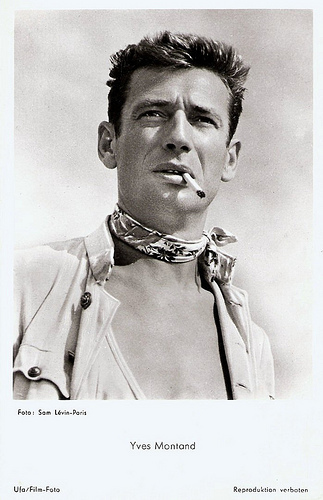
Yves Montand . German postcard by Ufa (Universum-Film Aktiengesellschaft), Berlin-Tempelhof, nr. FK 658. Retail price: 25 Pfg. Photo: Sam Lévin, Paris. Publicity still for Le salaire de la peur/The Wages of Fear (Henri-Georges Clouzot, 1953).
Diabolique
Véra Clouzot’s most famous film is undoubtedly her next, Les Diaboliques/Diabolique (Henri-Georges Clouzot, 1955).
This horror thriller (#179 in IMDb ’s Top 250) was an adaptation of a novel by Pierre Boileau and Thomas Narcejac, on whose novel D'Entre Les Morts (Among the Deaths) Alfred Hitchcock later based Vertigo (1958).
Clouzot played the long-suffering invalid wife of a cruel headmaster ( Paul Meurisse ). She conspires with his mistress ( Simone Signoret ) to kill him. After the murder is committed, his body disappears, and strange events begin to plague the two women.
Véra Clouzot then appeared in a supporting part in her husband’s next film, Les espions/The Spies (Henri-Georges Clouzot, 1957), starring Curd Jürgens and Peter Ustinov. She played a mute mental patient in this parody of espionage and political ideology set in a nursing home. It would be the last film in which she could be seen.
However she contributed to another film of her husband. She co-wrote the screenplay for La vérité/The Truth (Henri-Georges Clouzot, 1960). In this film Brigitte Bardot played a girl on trial for the murder of her lover.
In 1960 Véra Clouzot suddenly died of a heart attack in Paris. A morbid detail was that her character in Les Diaboliques had died the same way. Véra Clouzot was only 47.
In 1977 Hollywood remade Le Salaire de la Peur as Sorcerer (William Friedkin, 1977) and two decades later followed a Hollywood remake of Les Diaboliques, Diabolique (Jeremiah S. Chechik, 1996) with Sharon Stone as the mistress and Isabelle Adjani in Véra Clouzot’s role. Both remakes could not stand in the shadow of the original versions.
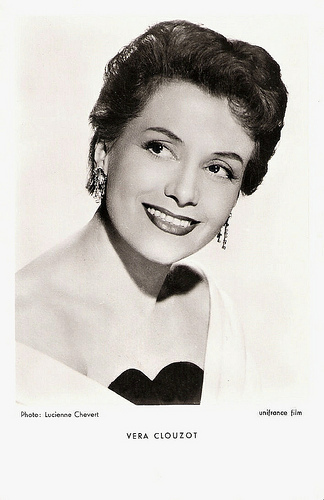
German postcard by Film und Bild, Berlin, no. A 816. Photo: Lucienne Chevert / Unifrance film.
Sources: Hal Erickson (AllMovie), (IMDb), Wikipedia (French), and .

French postcard by Editions P.I., Paris, no. 492. Photo: Lucienne Chevert.
Coup de Foudre
Véra (also Vera) Clouzot was born as Véra Gibson-Amado in Rio de Janeiro, Brazil, in 1913.
She was the daughter of one of Brazil's most notorious political figures, Gilberto Amado. Amado was a congressman, writer, journalist and lawyer, and the ex-President of the United Nations' International Law Committee. In 1915, he shot to death fellow writer and poet Aníbal Teóphilo in an official ceremony at the Jornal do Commercio for disagreeing with his opinions on literature. Amado was acquitted.
His daughter met in 1941 the French actor Léo Lapara. He was a member of the theatre company of Louis Jouvet , which happened to be on tour in Rio de Janeiro. They married shortly after and she then joined the company for a tour in South America that lasted for nearly four years.
After the Second World War they returned to France and Vera settled in Paris. Louis Jouvet took over the direction of the Theatre Athenée and he continued to give Véra small roles.
In 1947, Lapara played a role in the film Quai des Orfevres/Quay of the Goldsmiths (Henri-Georges Clouzot, 1947). When Véra met the director on the set it was a ‘coup de foudre’: love at first sight. Clouzot hired her as a script girl for his next film Miquette et sa mere/Miquette (Henri-Georges Clouzot, 1949) starring Louis Jouvet . Vera divorced Lapara, and in 1950 she married Clouzot.

French postcard by Cinédis. Clouzot is coiffed as her character in Le Salaire de la Peur/The Wages of Fear (Henri-Georges Clouzot, 1953).
The French Hitchcock
Véra Clouzot would play the female lead in her husband's next film, Le Salaire de la Peur/The Wages of Fear (Henri-Georges Clouzot, 1953).
Her co-stars in this magnificent thriller (#166 in IMDb ’s Top 250) were Charles Vanel and Yves Montand . They played Frenchmen stranded in South-America, who are hired to transport an urgent nitro-glycerine shipment without the equipment that would make it safe.
Véra Clouzot did her own stunts in the film, which included getting on a moving truck and being pushed away to the ground.
IMDb reviewer Dennis Littrell writes about her performance: “Véra Clouzot plays Linda who first appears scrubbing the floor in an open-air bistro. She is rather extraordinary herself, finely made up and creamy white like a star of the silent film era. She grovels a lot, especially for Mario (Montand). She provides the counter-point, the contrast for the testosterone action of the movie.”
At AllMovie , Hal Erickson adds about the film: “The first half of the film slowly, methodically introduces the characters and their motivations. The second half -- the drive itself -- is a relentless, goosebump-inducing assault on the audience's senses.”
Le Salaire de la Peur was the winner of the Grand Prix at the Cannes Festival and made Henri-Georges Clouzot known as ‘the French Hitchcock’.

Yves Montand . German postcard by Ufa (Universum-Film Aktiengesellschaft), Berlin-Tempelhof, nr. FK 658. Retail price: 25 Pfg. Photo: Sam Lévin, Paris. Publicity still for Le salaire de la peur/The Wages of Fear (Henri-Georges Clouzot, 1953).
Diabolique
Véra Clouzot’s most famous film is undoubtedly her next, Les Diaboliques/Diabolique (Henri-Georges Clouzot, 1955).
This horror thriller (#179 in IMDb ’s Top 250) was an adaptation of a novel by Pierre Boileau and Thomas Narcejac, on whose novel D'Entre Les Morts (Among the Deaths) Alfred Hitchcock later based Vertigo (1958).
Clouzot played the long-suffering invalid wife of a cruel headmaster ( Paul Meurisse ). She conspires with his mistress ( Simone Signoret ) to kill him. After the murder is committed, his body disappears, and strange events begin to plague the two women.
Véra Clouzot then appeared in a supporting part in her husband’s next film, Les espions/The Spies (Henri-Georges Clouzot, 1957), starring Curd Jürgens and Peter Ustinov. She played a mute mental patient in this parody of espionage and political ideology set in a nursing home. It would be the last film in which she could be seen.
However she contributed to another film of her husband. She co-wrote the screenplay for La vérité/The Truth (Henri-Georges Clouzot, 1960). In this film Brigitte Bardot played a girl on trial for the murder of her lover.
In 1960 Véra Clouzot suddenly died of a heart attack in Paris. A morbid detail was that her character in Les Diaboliques had died the same way. Véra Clouzot was only 47.
In 1977 Hollywood remade Le Salaire de la Peur as Sorcerer (William Friedkin, 1977) and two decades later followed a Hollywood remake of Les Diaboliques, Diabolique (Jeremiah S. Chechik, 1996) with Sharon Stone as the mistress and Isabelle Adjani in Véra Clouzot’s role. Both remakes could not stand in the shadow of the original versions.

German postcard by Film und Bild, Berlin, no. A 816. Photo: Lucienne Chevert / Unifrance film.
Sources: Hal Erickson (AllMovie), (IMDb), Wikipedia (French), and .
Published on November 04, 2014 23:00
November 3, 2014
Trio Lescano
This weekend I watched the Italian mini-series Le Ragazze dello Swing/The swing girls (Maurizio Zaccaro, 2010) . It is based on the Trio Lescano story, about three Dutch sisters singing Italian swing and jazz during the Musolini era. The wonderful series featured Hungarian actress Andrea Osvárt as Alessandra and Dutch actresses Lotte Verbeek as Giuditta and Elise Schaap as Caterinetta. The songs were not performed by the actresses but by the group The Blue Dolls. Wow, how it swinged. And now I can't get their hit 'Tullipan' out of my head: Tulli-Tulli-Tullipan...
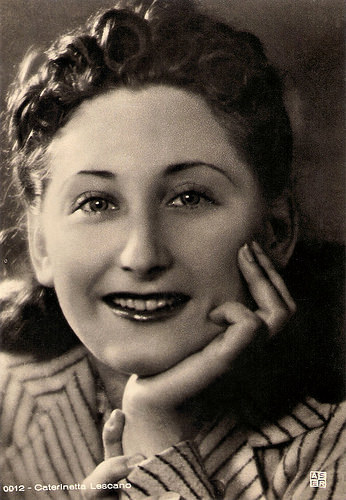
Caterinetta Lescano. Italian postcard by Aser, Roma, no. N 0012.
The Sunday Sisters
Trio Lescano was a trio of Dutch sisters singing Italian swing: Alexandra (1910-1987), Judith (several sources say Judik) (1913-2007), and Kitty Leschan (1919-1965), whose names were Italianized into Alessandra, Giuditta and Caterinetta (Caterina) Lescano.
The three girls were born in Gouda (Alexandra) and The Hague. Their parents were August Alexander Leschan, a Budapest-born contortionist, and Eva de Leeuw (1892-1985), a Dutch Jewish operetta singer. They grew up in the Netherlands, where two of them worked with their mother as acrobats under the name 'The Sunday Sisters'.
They arrived in Italy in 1935, and started to dance in a variety show. They were discovered by Carlo Prato, artistic director of the Turin department of the EIAR radio (later the RAI). Soon they became known as background vocalists under the name of Trio Lescano.
They made their first record in 1936 for Parlophone, ‘Guarany Guarana’. The next year they became part of the popular Cetra Orchestra, directed by Pippo Barzizza. In 1938 they had their breakthrough with the song ‘E arrivato l’Ambasciatore’.
That year, they also made their film debut with an appearance in the drama L'argine/The Dyke (Corrado D'Errico, 1938) starring Luisa Ferida and Gino Cervi . In 1942, they also appeared in Pazzo d'amore/Crazy Love (Giacomo Gentilomo, 1942) starring Renato Rascel .
The Trio Lescano's style was based on sophisticated vocal virtuosity - a technique called ‘vocalese’ - on swing and jazz harmonisations. Their greatest hits include ‘Signorine Grandi Firme’, ‘Maramao perché sei morto’, ‘Ma le gambe’, ‘Pippo non lo sa’, ‘Camminando sotto la pioggia’, ‘La famiglia canterina’, ‘C’è un’orchestra sincopata’, Il pinguino innamorato’, and 'Ciribiribin'.
And of course 'Tullipan', a cover of Tulip Time by the Andrews Sisters, which sold more than 350.000 records in Italy.
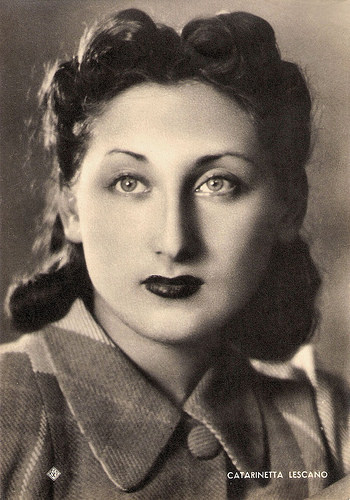
Caterinetta Lescano. Italian postcard by Aser, Roma, no. N 0019. Photo: E.I.A.R. / Romeo.
The three graces of the microphone
In 1941 the Lescano sisters became Italian citizens. This made big news on the Italian papers, who had invented for them such definitions as ‘the three graces of the microphone’, ‘the century's sensation’ and 'the sisters who materialize the mystery of the heavenly trinity’.
Even Benito Mussolini, passing by their balcony one day, reportedly recognized them and stopped to greet them. But just a year later, their golden period ended. In 1942, the radio bosses sent the three sisters away because their mother was Jewish.
A year later North Italy was occupied by the Germans. According to Allessandra, the Lescano sisters were arrested on suspicion of espionage. The accusation was that their songs contained encoded messages for the enemy.
Immediately after the war, their comeback was not very successful so they decided to try their luck elsewhere. Caterinetta left the trio and tried a solo career. In 1947, the two other sisters left for Argentina, where they toured for several years. Caterinetta was replaced by the Italian singer Maria Bria. Their artistic career in Latin America continued until the mid-fifties. Then, the ladies took up ordinary jobs and split up.
They were rediscovered after the Dutch documentary film Tulip Time: The Rise and Fall of the Trio Lescano (Tonino Boniotti, Marco De Stefanis, 2008), which premiered at the San Francisco Jewish Film Festival 2008.
In 2010, the Italian television produced the mini-series Le Ragazze dello Swing/The swing girls (Maurizio Zaccaro, 2010) based on the Lescano story. It featured Hungarian actress Andrea Osvárt as Alessandra and Dutch actresses Lotte Verbeek as Giuditta and Elise Schaap as Caterinetta. The mother of the Lescano girls was played by Sylvia Kristel , in her final role.
The actresses did not sing themselves, the songs were performed by the group The Blue Dolls. Outside Italy, the series was released on DVD.
Trio Lescano sings Ultimissime (1938) by Ansaldo, with the orchestra of Pipo Barzizza. Source: Kaatjeaster (YouTube).
Trio Lescano sings Oh! Mama. Clip from Tulip Time: The Rise and Fall of the Trio Lescano. Source: Kaatjeaster (YouTube).
Scene from Le Ragazze dello Swing/The swing girls (Maurizio Zaccaro, 2010). Source: Distratta80 (YouTube).
The Blue Dolls sing Maramao Perchè Sei Morto?. Source: The Blue Dolls (YouTube).
Sources: Wikipedia (English and Italian) and IMDb.

Caterinetta Lescano. Italian postcard by Aser, Roma, no. N 0012.
The Sunday Sisters
Trio Lescano was a trio of Dutch sisters singing Italian swing: Alexandra (1910-1987), Judith (several sources say Judik) (1913-2007), and Kitty Leschan (1919-1965), whose names were Italianized into Alessandra, Giuditta and Caterinetta (Caterina) Lescano.
The three girls were born in Gouda (Alexandra) and The Hague. Their parents were August Alexander Leschan, a Budapest-born contortionist, and Eva de Leeuw (1892-1985), a Dutch Jewish operetta singer. They grew up in the Netherlands, where two of them worked with their mother as acrobats under the name 'The Sunday Sisters'.
They arrived in Italy in 1935, and started to dance in a variety show. They were discovered by Carlo Prato, artistic director of the Turin department of the EIAR radio (later the RAI). Soon they became known as background vocalists under the name of Trio Lescano.
They made their first record in 1936 for Parlophone, ‘Guarany Guarana’. The next year they became part of the popular Cetra Orchestra, directed by Pippo Barzizza. In 1938 they had their breakthrough with the song ‘E arrivato l’Ambasciatore’.
That year, they also made their film debut with an appearance in the drama L'argine/The Dyke (Corrado D'Errico, 1938) starring Luisa Ferida and Gino Cervi . In 1942, they also appeared in Pazzo d'amore/Crazy Love (Giacomo Gentilomo, 1942) starring Renato Rascel .
The Trio Lescano's style was based on sophisticated vocal virtuosity - a technique called ‘vocalese’ - on swing and jazz harmonisations. Their greatest hits include ‘Signorine Grandi Firme’, ‘Maramao perché sei morto’, ‘Ma le gambe’, ‘Pippo non lo sa’, ‘Camminando sotto la pioggia’, ‘La famiglia canterina’, ‘C’è un’orchestra sincopata’, Il pinguino innamorato’, and 'Ciribiribin'.
And of course 'Tullipan', a cover of Tulip Time by the Andrews Sisters, which sold more than 350.000 records in Italy.

Caterinetta Lescano. Italian postcard by Aser, Roma, no. N 0019. Photo: E.I.A.R. / Romeo.
The three graces of the microphone
In 1941 the Lescano sisters became Italian citizens. This made big news on the Italian papers, who had invented for them such definitions as ‘the three graces of the microphone’, ‘the century's sensation’ and 'the sisters who materialize the mystery of the heavenly trinity’.
Even Benito Mussolini, passing by their balcony one day, reportedly recognized them and stopped to greet them. But just a year later, their golden period ended. In 1942, the radio bosses sent the three sisters away because their mother was Jewish.
A year later North Italy was occupied by the Germans. According to Allessandra, the Lescano sisters were arrested on suspicion of espionage. The accusation was that their songs contained encoded messages for the enemy.
Immediately after the war, their comeback was not very successful so they decided to try their luck elsewhere. Caterinetta left the trio and tried a solo career. In 1947, the two other sisters left for Argentina, where they toured for several years. Caterinetta was replaced by the Italian singer Maria Bria. Their artistic career in Latin America continued until the mid-fifties. Then, the ladies took up ordinary jobs and split up.
They were rediscovered after the Dutch documentary film Tulip Time: The Rise and Fall of the Trio Lescano (Tonino Boniotti, Marco De Stefanis, 2008), which premiered at the San Francisco Jewish Film Festival 2008.
In 2010, the Italian television produced the mini-series Le Ragazze dello Swing/The swing girls (Maurizio Zaccaro, 2010) based on the Lescano story. It featured Hungarian actress Andrea Osvárt as Alessandra and Dutch actresses Lotte Verbeek as Giuditta and Elise Schaap as Caterinetta. The mother of the Lescano girls was played by Sylvia Kristel , in her final role.
The actresses did not sing themselves, the songs were performed by the group The Blue Dolls. Outside Italy, the series was released on DVD.
Trio Lescano sings Ultimissime (1938) by Ansaldo, with the orchestra of Pipo Barzizza. Source: Kaatjeaster (YouTube).
Trio Lescano sings Oh! Mama. Clip from Tulip Time: The Rise and Fall of the Trio Lescano. Source: Kaatjeaster (YouTube).
Scene from Le Ragazze dello Swing/The swing girls (Maurizio Zaccaro, 2010). Source: Distratta80 (YouTube).
The Blue Dolls sing Maramao Perchè Sei Morto?. Source: The Blue Dolls (YouTube).
Sources: Wikipedia (English and Italian) and IMDb.
Published on November 03, 2014 22:00
November 2, 2014
Charles Martinelli
Charles Martinelli (1882-1954) was a French actor, who became famous for his interpretation of Porthos in Les trois mousquetaires/The Three Musketeers (1921).
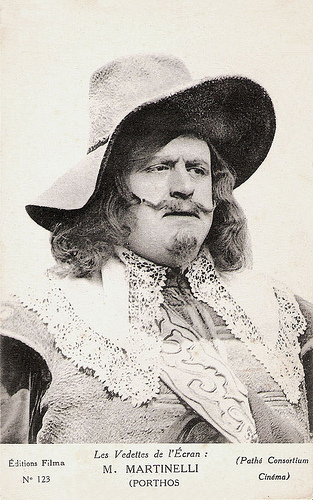
French postcard by Editions Filma, no. 123. Photo: Pathé Consortium Cinéma. Charles Martinelli as Porthos.
Silent Super-Serial
Charles Martinelli, whose real name was Charles Martinet, was born in Paris in 1882.
He started out as actor and singer, performing Panurge by Massenet and playing in Boubouroche by Georges Courteline. For then years he was the Chair of the Union des Artistes Français.
According to IMDb his first film part was in Le petit poucet/Tom Thumb (Robert Boudrioz, 1920), produced by Abel Gance . The year 1920 might be a mistake though, as the French magazine Cinéa of July 1922 announced that Martinelli would start to play the ogre while Christiane Delval played Tom Thumb. It also remarked that Martinelli was already known from his part of Porthos in Les trois mousquetaires (1921).
Indeed, it seems that Martinelli had his real breakthrough with the French historical adventure film Les trois mousquetaires/The Three Musketeers (1921), directed by Henri Diamant-Berger and adapted from Alexandre Dumas père’s classic novel, published in 1844.
The script by Auguste Macquet follows the classic novel by Alexandre Dumas père very faithfully. Martinelli played the good-hearted, rotund Porthos, opposite Aimé Simon-Girard as D’Artagnan, Henri Rollan as Athos, Pierre de Guingand as Aramis, Edouard de Max as Richelieu, Pierrette Madd as Constance, Claude Merelle as Mylady De Winter, and Armand Bernard as Planchet.
Les trois mousquetaires had the gigantic budget of 2.5 million French francs. It has wonderful performances, great looking sets (partly filmed on locations as the Chenonceau castle, Chartres and the Pérouges citadel), and authentic recreations of 17th century costumes. Responsible for sets and costumes was the French reputed architect and designer Robert Mallet-Stevens.
The film was divided into one-hour chapters, designed to be released as a serial in consecutive weeks over a three-month period. This silent super-serial was produced by Pathé Frères.
Parallel to Diamant-Berger’s version, Fred Niblo shot a rival version in the US starring Douglas Fairbanks as D’Artagnan, The Three Musketeers (Fred Niblo, 1921). Though entertaining, it was much more loosely adapted. The success of Les trois mousquetaires was aided by an arrangement with United Artists that kept Fairbanks’s The Three Musketeers from being distributed in France and much of Europe.
All copies of the 1921 version were thought to be destroyed by the Nazis during the Second World War, but in 1995 a print was rediscovered, and remastered into a new version. It was already the second adaptation of the famous adventure novel by Alexandre Dumas père, after a first adaptation in 1913, but it wouldn’t be the last either.
In 1933 Henri Diamant-Berger made a new, sound version of Les trois mousquetaires. While Thomy Bourdelle now played Porthos, Aimé Simon-Girard starred again as D' Artagnan, Henri Rollan returned as Athos, and Henry Baudin also reprised his role as Le comte de Rochefort.
The succes of the 1921 version pushed Pathé in filming Dumas’ sequel Vingt ans après as well, which was released in 1922 and was again directed by Diamant-Berger. Martinelli remained as Porthos, and Rolland, Guingand and Bernard returned, but D’Artagnan was played by Jean Yonnel.
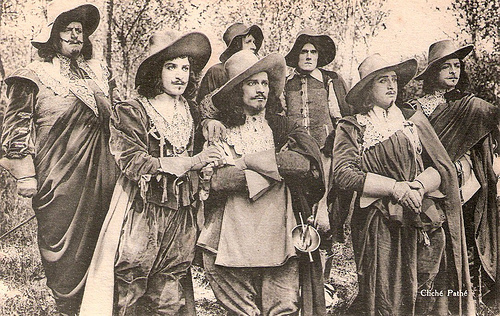
French postcard by M. Le Deley, Paris. Photo: Pathé Consortium Cinéma. Publicity still for Les Trois Mousquetaires/The Three Musketeers (Henri Diamant Berger, 1921). The four musketeers were played by Aimé Simon-Girard (D'Artagnan), Henri Rollan (Athos), Pierre de Guingand (Aramis) and Charles Martinelli (Porthos).
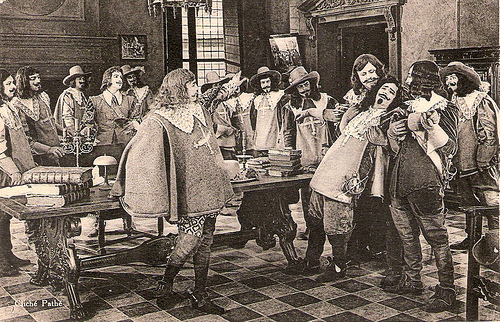
French postcard by M. Le Deley, Paris. Photo: Pathé Consortium Cinéma. Publicity still for Les Trois Mousquetaires/The Three Musketeers (Henri Diamant Berger, 1921).
Mad Scientist
Charles Martinelli remained attached to Diamant-Berger’s films in 1921-1923, mostly comedies. He had the lead in the adaptation of the play Boubouroche (1921). Before, he had already starred in the play on stage.
He also acted in Diamant-Berger’s Le mauvais garçon (1923), Gonzague (1923), Jim Bougne, boxeur (1923), L’accordeur (1923) and L’affaire de la rue de Lourcine (1923), all starring Maurice Chevalier , and Le roi de la vitesse (1923), starring Pierre de Guingand .
In those films, several of the actors of Les trois mousquetaires and Vingts ans après returned, including Pierrette Madd , Marguerite Moreno and Louis Préfils. They were joined by popular vaudeville comedians like Georges Milton and Florelle , who started their film careers here.
Martinelli then did three comedies with Robert Saidreau: Ma tante d’Honfleur (1923), A la gare (1923, released 1925) and Le fil à la patte (1923), all with Armand Bernard .
In 1924 Martinelli played the mad scientist in the classic Paris qui dort (René Clair, 1924). In this mad cap science fiction film all the Parisians are in a state of Sleeping Beauty-like sleep. A few odd outsiders are awake, including the man on the Eiffel Tower, played by Henri Rollan , and a pilot ( Albert Préjean ) and his passengers. Préjean had started his career in Diamant-Berger’s Les trois mousquetaires and had become a regular of his comedies as well. Paris qui dort was also produced by Henri Diamant-Berger’s company, Films Diamant.
After that Martinelli did one last film in the silent era, playing Farigoule in La Tournée Farigoule (Marcel Manchez, 1926), with Madeleine Guitty and Jane Pierson.
In the sound era Martinelli played in three films of the 1930s. He was the head of police in G.W. Pabst’s Don Quichotte (1932, released 1933), starring Feodor Chaliapine as Don Quichotte and Dorville as Sancho Panza.
He played the emperor in the Franco-German coproduction Tambour battant (André Becler, Arthur Robison, 1933), starring Georges Rigaud, Josseline Gaël and Françoise Rosay .
His last part was in the comedy Un fichu métier (Pierre-Jean Ducis, 1938), starring Lucien Baroux.
Charles Martinelli died in Paris in 1954.
Since 1908 he was married to Germaine Jobert,who was a highly acclaimed concert singer during the interbellum years. Their son, Jean Martinelli, was born in 1909. For 21 years, he was a sociétaire of the Comédie Française, and afterwards he had an excellent career in private theatres, film and television. He died in 1983.
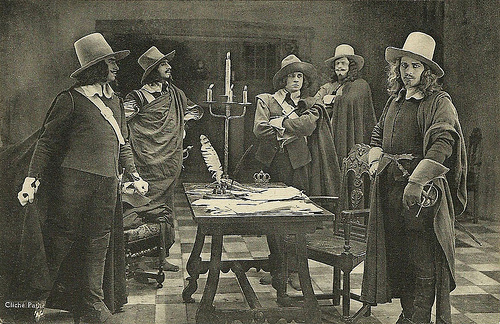
French postcard. Photo: Pathé. Publicity still for Vingt ans après/The Return of the Musketeers (1922, Henri Diamant-Berger). Collection: Didier Hanson. The four musketeers were played by Jean Yonnel (D'Artagnan), Henri Rollan (Athos), Pierre de Guingand (Aramis) and Charles Martinelli (Porthos).
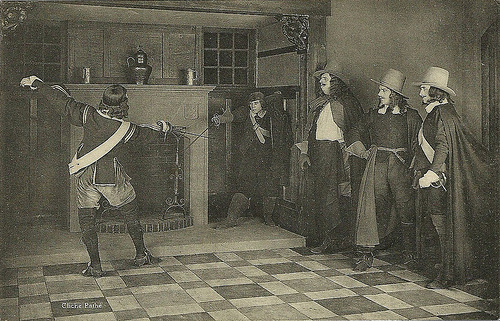
French postcard. Photo: Pathé. Publicity still for Vingt ans après/The Return of the Musketeers (1922, Henri Diamant-Berger). Collection: Didier Hanson.
Sources: Cineressources (French), Wikipedia (French) and .

French postcard by Editions Filma, no. 123. Photo: Pathé Consortium Cinéma. Charles Martinelli as Porthos.
Silent Super-Serial
Charles Martinelli, whose real name was Charles Martinet, was born in Paris in 1882.
He started out as actor and singer, performing Panurge by Massenet and playing in Boubouroche by Georges Courteline. For then years he was the Chair of the Union des Artistes Français.
According to IMDb his first film part was in Le petit poucet/Tom Thumb (Robert Boudrioz, 1920), produced by Abel Gance . The year 1920 might be a mistake though, as the French magazine Cinéa of July 1922 announced that Martinelli would start to play the ogre while Christiane Delval played Tom Thumb. It also remarked that Martinelli was already known from his part of Porthos in Les trois mousquetaires (1921).
Indeed, it seems that Martinelli had his real breakthrough with the French historical adventure film Les trois mousquetaires/The Three Musketeers (1921), directed by Henri Diamant-Berger and adapted from Alexandre Dumas père’s classic novel, published in 1844.
The script by Auguste Macquet follows the classic novel by Alexandre Dumas père very faithfully. Martinelli played the good-hearted, rotund Porthos, opposite Aimé Simon-Girard as D’Artagnan, Henri Rollan as Athos, Pierre de Guingand as Aramis, Edouard de Max as Richelieu, Pierrette Madd as Constance, Claude Merelle as Mylady De Winter, and Armand Bernard as Planchet.
Les trois mousquetaires had the gigantic budget of 2.5 million French francs. It has wonderful performances, great looking sets (partly filmed on locations as the Chenonceau castle, Chartres and the Pérouges citadel), and authentic recreations of 17th century costumes. Responsible for sets and costumes was the French reputed architect and designer Robert Mallet-Stevens.
The film was divided into one-hour chapters, designed to be released as a serial in consecutive weeks over a three-month period. This silent super-serial was produced by Pathé Frères.
Parallel to Diamant-Berger’s version, Fred Niblo shot a rival version in the US starring Douglas Fairbanks as D’Artagnan, The Three Musketeers (Fred Niblo, 1921). Though entertaining, it was much more loosely adapted. The success of Les trois mousquetaires was aided by an arrangement with United Artists that kept Fairbanks’s The Three Musketeers from being distributed in France and much of Europe.
All copies of the 1921 version were thought to be destroyed by the Nazis during the Second World War, but in 1995 a print was rediscovered, and remastered into a new version. It was already the second adaptation of the famous adventure novel by Alexandre Dumas père, after a first adaptation in 1913, but it wouldn’t be the last either.
In 1933 Henri Diamant-Berger made a new, sound version of Les trois mousquetaires. While Thomy Bourdelle now played Porthos, Aimé Simon-Girard starred again as D' Artagnan, Henri Rollan returned as Athos, and Henry Baudin also reprised his role as Le comte de Rochefort.
The succes of the 1921 version pushed Pathé in filming Dumas’ sequel Vingt ans après as well, which was released in 1922 and was again directed by Diamant-Berger. Martinelli remained as Porthos, and Rolland, Guingand and Bernard returned, but D’Artagnan was played by Jean Yonnel.

French postcard by M. Le Deley, Paris. Photo: Pathé Consortium Cinéma. Publicity still for Les Trois Mousquetaires/The Three Musketeers (Henri Diamant Berger, 1921). The four musketeers were played by Aimé Simon-Girard (D'Artagnan), Henri Rollan (Athos), Pierre de Guingand (Aramis) and Charles Martinelli (Porthos).

French postcard by M. Le Deley, Paris. Photo: Pathé Consortium Cinéma. Publicity still for Les Trois Mousquetaires/The Three Musketeers (Henri Diamant Berger, 1921).
Mad Scientist
Charles Martinelli remained attached to Diamant-Berger’s films in 1921-1923, mostly comedies. He had the lead in the adaptation of the play Boubouroche (1921). Before, he had already starred in the play on stage.
He also acted in Diamant-Berger’s Le mauvais garçon (1923), Gonzague (1923), Jim Bougne, boxeur (1923), L’accordeur (1923) and L’affaire de la rue de Lourcine (1923), all starring Maurice Chevalier , and Le roi de la vitesse (1923), starring Pierre de Guingand .
In those films, several of the actors of Les trois mousquetaires and Vingts ans après returned, including Pierrette Madd , Marguerite Moreno and Louis Préfils. They were joined by popular vaudeville comedians like Georges Milton and Florelle , who started their film careers here.
Martinelli then did three comedies with Robert Saidreau: Ma tante d’Honfleur (1923), A la gare (1923, released 1925) and Le fil à la patte (1923), all with Armand Bernard .
In 1924 Martinelli played the mad scientist in the classic Paris qui dort (René Clair, 1924). In this mad cap science fiction film all the Parisians are in a state of Sleeping Beauty-like sleep. A few odd outsiders are awake, including the man on the Eiffel Tower, played by Henri Rollan , and a pilot ( Albert Préjean ) and his passengers. Préjean had started his career in Diamant-Berger’s Les trois mousquetaires and had become a regular of his comedies as well. Paris qui dort was also produced by Henri Diamant-Berger’s company, Films Diamant.
After that Martinelli did one last film in the silent era, playing Farigoule in La Tournée Farigoule (Marcel Manchez, 1926), with Madeleine Guitty and Jane Pierson.
In the sound era Martinelli played in three films of the 1930s. He was the head of police in G.W. Pabst’s Don Quichotte (1932, released 1933), starring Feodor Chaliapine as Don Quichotte and Dorville as Sancho Panza.
He played the emperor in the Franco-German coproduction Tambour battant (André Becler, Arthur Robison, 1933), starring Georges Rigaud, Josseline Gaël and Françoise Rosay .
His last part was in the comedy Un fichu métier (Pierre-Jean Ducis, 1938), starring Lucien Baroux.
Charles Martinelli died in Paris in 1954.
Since 1908 he was married to Germaine Jobert,who was a highly acclaimed concert singer during the interbellum years. Their son, Jean Martinelli, was born in 1909. For 21 years, he was a sociétaire of the Comédie Française, and afterwards he had an excellent career in private theatres, film and television. He died in 1983.

French postcard. Photo: Pathé. Publicity still for Vingt ans après/The Return of the Musketeers (1922, Henri Diamant-Berger). Collection: Didier Hanson. The four musketeers were played by Jean Yonnel (D'Artagnan), Henri Rollan (Athos), Pierre de Guingand (Aramis) and Charles Martinelli (Porthos).

French postcard. Photo: Pathé. Publicity still for Vingt ans après/The Return of the Musketeers (1922, Henri Diamant-Berger). Collection: Didier Hanson.
Sources: Cineressources (French), Wikipedia (French) and .
Published on November 02, 2014 22:30
Régine Dumien
Sweet 'little angel' Régine Dumien (1914-1979) was a popular child star of the French silent cinema of the early 1920s.
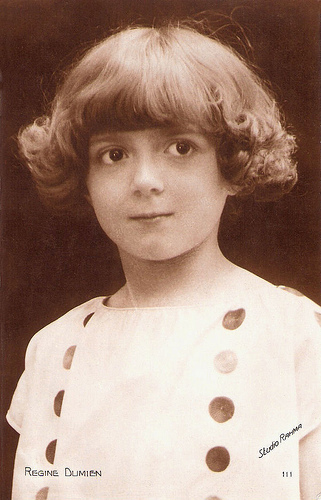
French postcard by Cinémagazine-Edition, no. 111. Photo: Studio Rahma.
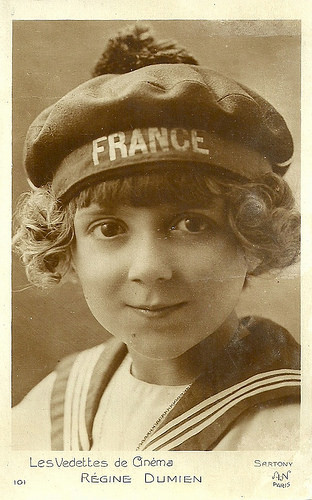
French postcard in the Les Vedettes de Cinéma series by Editions A.N., Paris, no. 101. Photo: Sartony.
To Be Or Not To Be
Régina France Dumien was born in Paris, France, in 1914. Six years later, she already made her film debut in the title role of Petit ange/Little Angel (Luitz-Morat, Pierre Régnier, 1920). Her role and the film were a huge success.
Famous film critic Louis Delluc wrote in the journal Paris-Midi (30-12-1920): "This pleasant film comedy represents the intelligent assimilation of the average American cinema. A detailed technique, a funny idea and ingeniously developed, a frank, lively, precise drawing, with taste, movement, and simplicity."
The following year, the 6-year-old Régine had a small part in a film by the famous avant-garde director Germaine Dulac, La mort du soleil/The Death of the Sun (1921) starring André Nox.
She then appeared with Rita Jolivet and Gabriel Signoret in the Film d’Art production Roger la Honte/Roger the Shame (Jacques de Baroncelli, 1922). That year she also appeared in the popular film serial Mysteries of Paris/Mysteries of Paris (Charles Burguet, 1922) in the role of the young Fleur-de-Marie, played as an adult by Huguette Duflos .
She played the title role of La loupiote (Georges Hatot, 1922), written by Arthur Bernède and Aristide Bruant. In the Pathé Frères drama Être ou ne pas être/To Be of Not To Be (René Leprince, 1922), she starred opposite Léon Mathot and Renée Sylvaire .
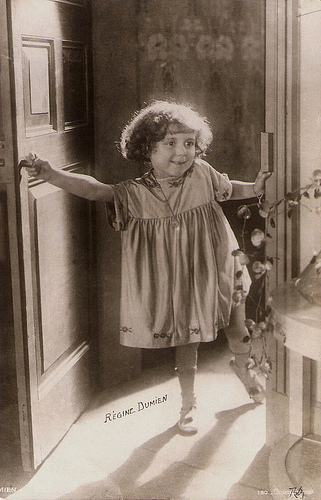
French postcard by Cinémagazine-Edition, no. 130.
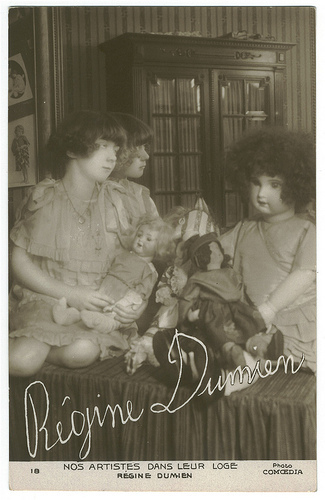
French postcard in the series Nos artistes dans leur loge, no. 18. Photo: Comoedia. Collection: Manuel Palomino Arjona (Performing Arts / Artes Escénicas).
Pathé Baby
In 1923 Régine Dumien featured in the sequel to her first film: Petit ange et son pantin/Little Angel and her Puppet (Luitz-Morat, 1923).
That same year the now 9-years-old star could be seen in the Pathé Baby shorts La Tartine/Bread and Jam (1923) and Le Bon Oncle/The Good Uncle (1923) about an uncle who enjoys a beautiful siesta after lunch, but then has to cope with Régine's frolics.
In 1924 she appeared in four films: L'ombre du bonheur/The Shadow of Happiness (Gaston Roudès, 1924) with France Dhélia, Le chemin de Roseland/The Road of Roseland (Maurice Gleize, 1924), La joueuse d'orgue/The Organ Player (Charles Burguet, 1924), and Grand-mère/Grandmother (Albert-Francis Bertoni, 1924) with Constant Rémy.
This would also be her last film. Why stopped her film career then, when she was only 10 years old? The only further information on Régine Dumien that I could find on the web is that she died in 1979, in Villepinte, France, at the age of 64.
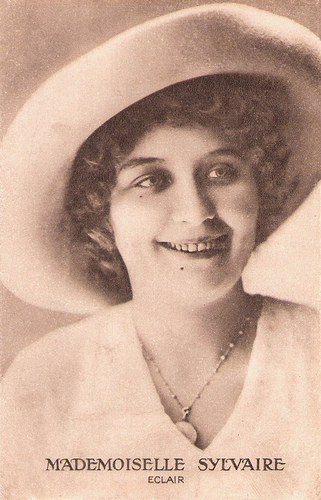
Renée Sylvaire . French postcard. Photo: Eclair.
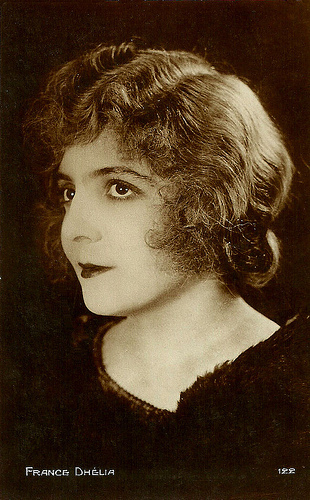
France Dhélia . French postcard by Cinémagazine, no. 122.
Sources: Henri Bousquet (De Pathé Frères à Pathé Cinéma), Grahame L. Newnham (Pathe Film), and .

French postcard by Cinémagazine-Edition, no. 111. Photo: Studio Rahma.

French postcard in the Les Vedettes de Cinéma series by Editions A.N., Paris, no. 101. Photo: Sartony.
To Be Or Not To Be
Régina France Dumien was born in Paris, France, in 1914. Six years later, she already made her film debut in the title role of Petit ange/Little Angel (Luitz-Morat, Pierre Régnier, 1920). Her role and the film were a huge success.
Famous film critic Louis Delluc wrote in the journal Paris-Midi (30-12-1920): "This pleasant film comedy represents the intelligent assimilation of the average American cinema. A detailed technique, a funny idea and ingeniously developed, a frank, lively, precise drawing, with taste, movement, and simplicity."
The following year, the 6-year-old Régine had a small part in a film by the famous avant-garde director Germaine Dulac, La mort du soleil/The Death of the Sun (1921) starring André Nox.
She then appeared with Rita Jolivet and Gabriel Signoret in the Film d’Art production Roger la Honte/Roger the Shame (Jacques de Baroncelli, 1922). That year she also appeared in the popular film serial Mysteries of Paris/Mysteries of Paris (Charles Burguet, 1922) in the role of the young Fleur-de-Marie, played as an adult by Huguette Duflos .
She played the title role of La loupiote (Georges Hatot, 1922), written by Arthur Bernède and Aristide Bruant. In the Pathé Frères drama Être ou ne pas être/To Be of Not To Be (René Leprince, 1922), she starred opposite Léon Mathot and Renée Sylvaire .

French postcard by Cinémagazine-Edition, no. 130.

French postcard in the series Nos artistes dans leur loge, no. 18. Photo: Comoedia. Collection: Manuel Palomino Arjona (Performing Arts / Artes Escénicas).
Pathé Baby
In 1923 Régine Dumien featured in the sequel to her first film: Petit ange et son pantin/Little Angel and her Puppet (Luitz-Morat, 1923).
That same year the now 9-years-old star could be seen in the Pathé Baby shorts La Tartine/Bread and Jam (1923) and Le Bon Oncle/The Good Uncle (1923) about an uncle who enjoys a beautiful siesta after lunch, but then has to cope with Régine's frolics.
In 1924 she appeared in four films: L'ombre du bonheur/The Shadow of Happiness (Gaston Roudès, 1924) with France Dhélia, Le chemin de Roseland/The Road of Roseland (Maurice Gleize, 1924), La joueuse d'orgue/The Organ Player (Charles Burguet, 1924), and Grand-mère/Grandmother (Albert-Francis Bertoni, 1924) with Constant Rémy.
This would also be her last film. Why stopped her film career then, when she was only 10 years old? The only further information on Régine Dumien that I could find on the web is that she died in 1979, in Villepinte, France, at the age of 64.

Renée Sylvaire . French postcard. Photo: Eclair.

France Dhélia . French postcard by Cinémagazine, no. 122.
Sources: Henri Bousquet (De Pathé Frères à Pathé Cinéma), Grahame L. Newnham (Pathe Film), and .
Published on November 02, 2014 00:00
November 1, 2014
La Gioconda (1917)
Polish singer and actress Helena Makowska (1893-1964) or Elena Malowska was a beautiful diva of the Italian silent cinema in the 1910s. She played the title role in the Ambrosio production La Gioconda (Eleuterio Rodolfi, 1917), based on a play by Gabriele D'Annunzio. The IPA produced for this silent drama a series of sepia postcards.
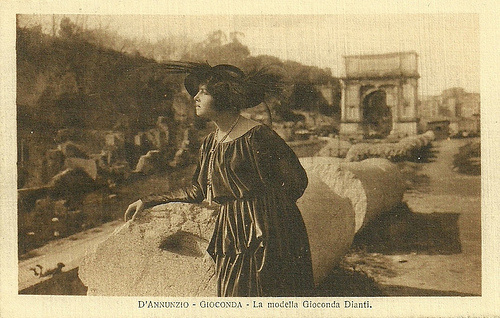
Italian postcard by IPA CT, no. 3654, Censura S. Prefetti, Terni, 18-4-1917. Photo: Ambrosio. Caption: 'The model Gioconda Dianti.' At the Forum Romanum, Rome. Helena Makowska in La Gioconda (Eleuterio Rodolfi, 1917).
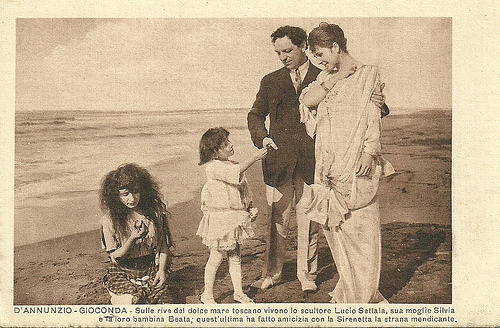
Italian postcard by IPA CT, no. 3872, V. Uff. Rev. St., Terni. Photo: Ambrosio. Caption: "On the banks of the sweet Tuscan coast the sculptor Lucio Settala, his wife Silvia and their daughter Beata live. The latter has befriended the Little Siren, a strange beggar girl." Umberto Mozzato as Settala, Mercedes Brignone as his wife, Linda Pini as 'Sirenetta' in La Gioconda (Eleuterio Rodolfi, 1917).
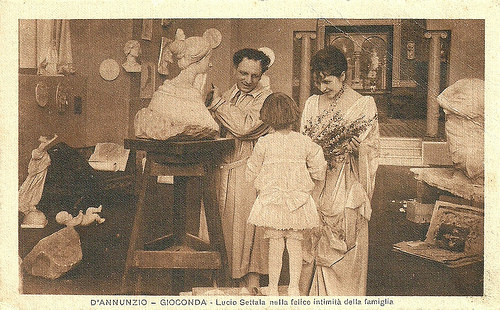
Italian postcard by IPA CT, no. 3654, V. Uff. Rev. St., Terni. Photo: Ambrosio. Caption: "Lucio Settala in the happy intimacy of the family." Umberto Mozzato as Settala and Mercedes Brignone as his wife Silvia in La Gioconda (Eleuterio Rodolfi, 1917).
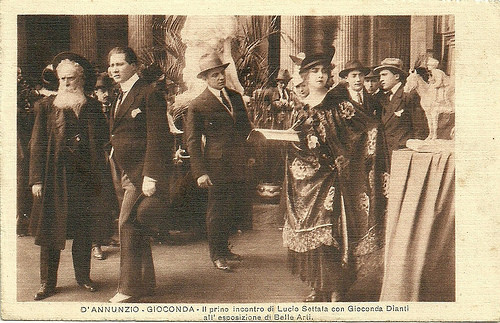
Italian postcard by IPA CT, no. 3880, V. Uff. Rev. St., Terni. Photo: Ambrosio. Caption: "The first encounter of Lucio Settala with Gioconda Dianti at the Fine Arts exhibition." Centre, Umberto Mozzato as Settala, right Helena Makowska as Gioconda Dianti in La Gioconda (Eleuterio Rodolfi, 1917).
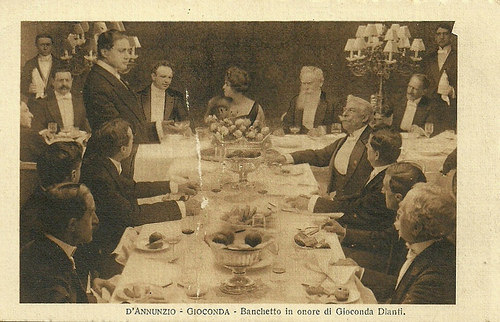
Italian postcard by IPA CT, no. 3661, Censura S. Prefetti, Terni, 18-4-1917. Photo: Ambrosio. Caption: "Banquet in honour of Gioconda Dianti." In the back, centre, Helena Makowska as Gioconda Dianti in La Gioconda (Eleuterio Rodolfi, 1917).
Seductive mistress
Famous sculptor Lucio Settala (Umberto Mozzato) lives on the Tuscan coast with his wife Silvia, daughter Beata and a beggar girl whom Beata befriends, la Sirenetta ( Linda Pini ).
At a Fine Arts exhibition, Lucio encounters the beautiful femme fatale Gioconda Dianti ( Helena Makowska ). She becomes his model for a statue of a female nude in an ecstatic pose.
More and more, Lucio falls in love with her and neglects his wife and child. Instead of his angelic wife ( Mercedes Brignone ), keeper of family values, he prefers his seductive mistress, the inspiration to his art. His wife suffers in silence.
At the convent of St. Mark, a monk tells Lucio and Gioconda the legend of an Egyptian mummy come to life (again played by Makowska) who becomes the voluptuous courtesan of the Pharaoh. When the people rebel against the Pharaoh’s spoiling of her, she shows herself just dressed in transparent veils to the rebels.
Silvia guards her husband’s abandoned studio, placing fresh flowers there. In the climax of the story, Silvia tries to regain her husband and struggles with the rival. In a moment of anger, Gioconda throws the statue on Silvia for which she has posed.
In order to save the masterpiece of her husband, Silvia sacrifices both her hands, reduced to stumps. His wife’s tragedy awakens the blinded infidel, who returns to the family hearth.
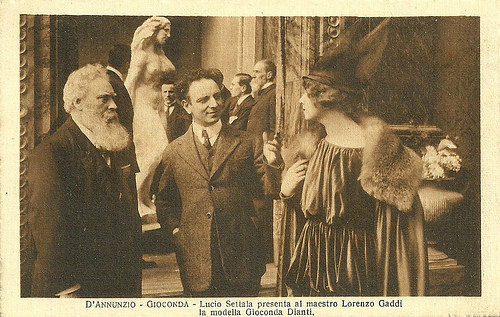
Italian postcard by IPA CT, no. 3663, Censura S. Prefetti, Terni, 18-4-1917. Photo: Ambrosio. Caption: 'Lucio Settala presents maestro Lorenzo Gaddi the model Gioconda Dianti.' Umberto Mozzato as the sculptor Lucio Settala and Helena Makowska as the model in La Gioconda (Eleuterio Rodolfi, 1917).
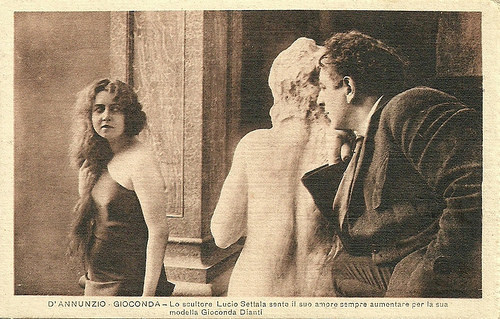
Italian postcard by IPA CT, no. 3877. Photo: Film della Soc. Ambrosio, Torino. V. Uff. Rev. St., Terni. Caption: "Sculptor Lucio Settala feels his love for his model Gioconda Dianti is ever expanding." Umberto Mozzato as Lucio Settala and Helena Makowska as Gioconda Dianti in La Gioconda (Eleuterio Rodolfi, 1917).

Italian postcard by IPA CT, no. 3876. Photo: Film della Soc. Ambrosio, Torino. V. Uff. Rev. St., Terni. Caption: "Lucio Settala is madly in love with his model Gioconda Dianti." Umberto Mozzato as Lucio Settala and Helena Makowska as Gioconda Dianti in La Gioconda (Eleuterio Rodolfi, 1917).
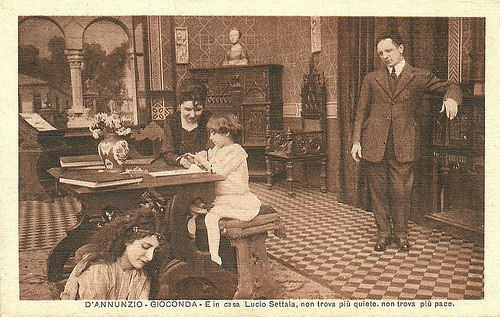
Italian postcard by IPA CT, no. 3881. Photo: Film della Soc. Ambrosio, Torino. V. Uff. Rev. St., Terni. Caption: "And at home Lucio Settala didn't find rest nor peace." Standing right, Settala (Umberto Mozzato), sitting at the table his wife Silvia (Mercedes Brignone), and sitting on the (fore-)ground la Sirenetta (Linda Pini) in La Gioconda (Eleuterio Rodolfi, 1917).
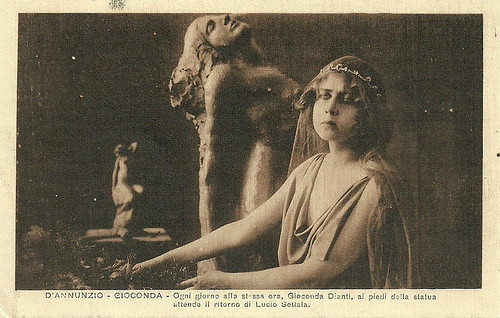
Italian postcard by IPA CT, no. 3662. Photo: Film della Soc. Ambrosio, Torino. V. Uff. Rev. St., Terni. Caption: "Every night at the same hour, Gioconda Dianti, at the feet of the statue awaited the return of Lucio Settala." Helena Makowska as the model Gioconda Dianti in La Gioconda (Eleuterio Rodolfi, 1917).
Mixed feelings
In 1916 Eleuterio Rodolfi directed La Gioconda for the Ambrosio film studio. He had written the script himself and had based it on the homonymous play by Gabriele D’Annunzio.
The film premiered in Rome on 24 January 1917.
While the play by D’Annunzio, written in 1898 and first performed in 1899, was received rather coolly at its premiere, the film was received with more mixed feelings.
While the Turin based journal La vita cinematografica thought Helena Makowska had a perfect body but a wooden expression, the Naples based journal La Cine-Fono, already a few months before the first public screening, wrote appraisal for its adaptation of D'Annunzio's play (considered very suitable to be filmed because of its theatricality), but also lauded the actor's performances of Makowska, Mozzato and Brignone.
La Gioconda is now considered a lost film.
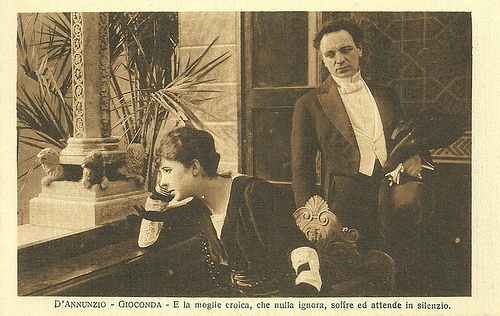
Italian postcard by IPA CT, no. 3670. Photo: Film della Soc. Ambrosio, Torino. V. Uff. Rev. St., Terni, 5-10-1916. Caption: "And the heroic wife, who knew very well what was going on, suffered and waited in silence." Mercedes Brignone and Umberto Mozzato in La Gioconda (Eleuterio Rodolfi, 1917).
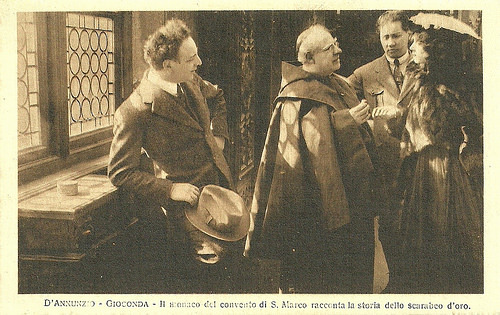
Italian postcard by IPA CT, no. 3662. Photo: Film della Società Ambrosio, Torino. ensura Terni, 18-4-1917. Caption: "The monk of the convent of St. Mark told the story of the golden scarabee." Helena Makowska as the model Gioconda Dianti but also as the Egyptian courtesan in the legend told, and left in the image Umberto Mozzato as the artist Lucio Settala in La Gioconda (Eleuterio Rodolfi, 1917).
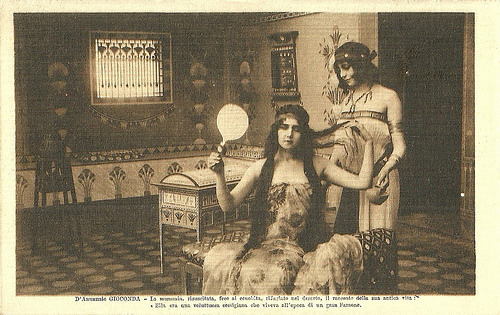
Italian postcard by IPA CT, no. 3873. Photo: Film della Società Ambrosio, Torino. Censura S. Prefett., Terni, 18-4-1917. Caption: "The resurrected mummy told the monk, refugee in the desert, the story of her ancient life: She had been a voluptuous courtesan who lived in the times of the great Pharaon." Helena Makowska as the Egyptian courtesan in La Gioconda (Eleuterio Rodolfi, 1917).
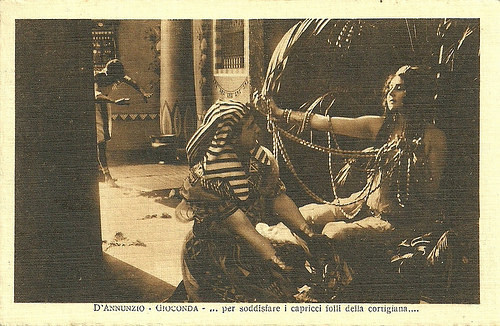
Italian postcard by IPA CT, no. 3879. Photo: Film della Società Ambrosio, Torino. Censura S. Prefett., Terni, 5-10-1916. Caption: "... in order to satisfy the mad caprice of the courtesan..." Helena Makowska as the Egyptian courtesan in La Gioconda (Eleuterio Rodolfi, 1917).
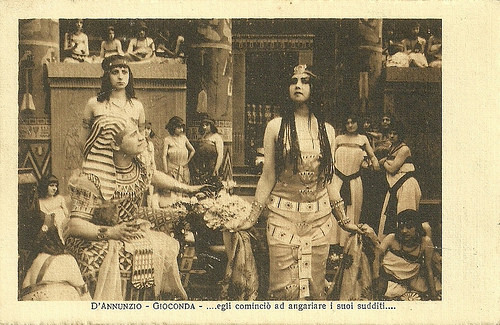
Italian postcard by IPA CT, no. 3662. Photo: Film della Società Ambrosio, Torino. Censura S. Prefett., Terni, 5-10-1916. Caption: "... he started to anger his subjects..." Helena Makowska as the Egyptian courtesan in La Gioconda (Eleuterio Rodolfi, 1917).
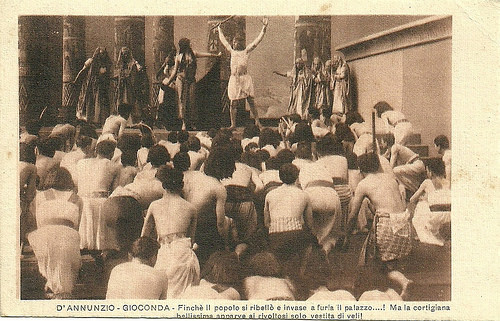
Italian postcard by IPA CT, no. 3874. Photo: Film della Società Ambrosio, Torino. V. Uff. Rev. St., Terni. Caption: "At last the populace rebelled and invaded the palace furiously...! But the courtesan appeared to the rebels dressed only in veils!" Helena Makowska as the Egyptian courtesan in La Gioconda (Eleuterio Rodolfi, 1917).
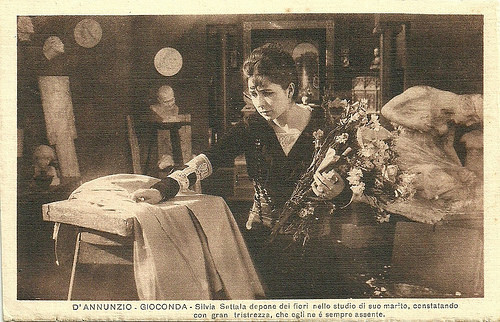
Italian postcard by IPA CT, no. 3871. Photo: Film della Società Ambrosio, Torino. V. Uff. Rev. St. Terni. Caption: "Sivia Settala deposes flowers in the studio of her husband, constating with great sadness, that he is ever more absent." Mercedes Brignone as Silvia Settala inLa Gioconda (Eleuterio Rodolfi, 1917).
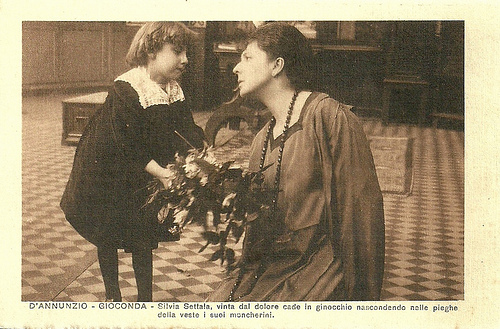
Italian postcard by IPA CT, no. 3660. Photo: IPA CT. Censura Terni 18-4-1917. Caption: "Struck by grief, Silvia Settala falls on her knees, hiding her stumps in the folds of her clothes." Mercedes Brignone as Silvia Settala inLa Gioconda (Eleuterio Rodolfi, 1917).
Sources: Vittorio Martinelli (Il cinema muto italiano, 1916 - Italian), Matilde Tortora (Italian), Wikipedia (Italian) and IMDb.

Italian postcard by IPA CT, no. 3654, Censura S. Prefetti, Terni, 18-4-1917. Photo: Ambrosio. Caption: 'The model Gioconda Dianti.' At the Forum Romanum, Rome. Helena Makowska in La Gioconda (Eleuterio Rodolfi, 1917).

Italian postcard by IPA CT, no. 3872, V. Uff. Rev. St., Terni. Photo: Ambrosio. Caption: "On the banks of the sweet Tuscan coast the sculptor Lucio Settala, his wife Silvia and their daughter Beata live. The latter has befriended the Little Siren, a strange beggar girl." Umberto Mozzato as Settala, Mercedes Brignone as his wife, Linda Pini as 'Sirenetta' in La Gioconda (Eleuterio Rodolfi, 1917).

Italian postcard by IPA CT, no. 3654, V. Uff. Rev. St., Terni. Photo: Ambrosio. Caption: "Lucio Settala in the happy intimacy of the family." Umberto Mozzato as Settala and Mercedes Brignone as his wife Silvia in La Gioconda (Eleuterio Rodolfi, 1917).

Italian postcard by IPA CT, no. 3880, V. Uff. Rev. St., Terni. Photo: Ambrosio. Caption: "The first encounter of Lucio Settala with Gioconda Dianti at the Fine Arts exhibition." Centre, Umberto Mozzato as Settala, right Helena Makowska as Gioconda Dianti in La Gioconda (Eleuterio Rodolfi, 1917).

Italian postcard by IPA CT, no. 3661, Censura S. Prefetti, Terni, 18-4-1917. Photo: Ambrosio. Caption: "Banquet in honour of Gioconda Dianti." In the back, centre, Helena Makowska as Gioconda Dianti in La Gioconda (Eleuterio Rodolfi, 1917).
Seductive mistress
Famous sculptor Lucio Settala (Umberto Mozzato) lives on the Tuscan coast with his wife Silvia, daughter Beata and a beggar girl whom Beata befriends, la Sirenetta ( Linda Pini ).
At a Fine Arts exhibition, Lucio encounters the beautiful femme fatale Gioconda Dianti ( Helena Makowska ). She becomes his model for a statue of a female nude in an ecstatic pose.
More and more, Lucio falls in love with her and neglects his wife and child. Instead of his angelic wife ( Mercedes Brignone ), keeper of family values, he prefers his seductive mistress, the inspiration to his art. His wife suffers in silence.
At the convent of St. Mark, a monk tells Lucio and Gioconda the legend of an Egyptian mummy come to life (again played by Makowska) who becomes the voluptuous courtesan of the Pharaoh. When the people rebel against the Pharaoh’s spoiling of her, she shows herself just dressed in transparent veils to the rebels.
Silvia guards her husband’s abandoned studio, placing fresh flowers there. In the climax of the story, Silvia tries to regain her husband and struggles with the rival. In a moment of anger, Gioconda throws the statue on Silvia for which she has posed.
In order to save the masterpiece of her husband, Silvia sacrifices both her hands, reduced to stumps. His wife’s tragedy awakens the blinded infidel, who returns to the family hearth.

Italian postcard by IPA CT, no. 3663, Censura S. Prefetti, Terni, 18-4-1917. Photo: Ambrosio. Caption: 'Lucio Settala presents maestro Lorenzo Gaddi the model Gioconda Dianti.' Umberto Mozzato as the sculptor Lucio Settala and Helena Makowska as the model in La Gioconda (Eleuterio Rodolfi, 1917).

Italian postcard by IPA CT, no. 3877. Photo: Film della Soc. Ambrosio, Torino. V. Uff. Rev. St., Terni. Caption: "Sculptor Lucio Settala feels his love for his model Gioconda Dianti is ever expanding." Umberto Mozzato as Lucio Settala and Helena Makowska as Gioconda Dianti in La Gioconda (Eleuterio Rodolfi, 1917).

Italian postcard by IPA CT, no. 3876. Photo: Film della Soc. Ambrosio, Torino. V. Uff. Rev. St., Terni. Caption: "Lucio Settala is madly in love with his model Gioconda Dianti." Umberto Mozzato as Lucio Settala and Helena Makowska as Gioconda Dianti in La Gioconda (Eleuterio Rodolfi, 1917).

Italian postcard by IPA CT, no. 3881. Photo: Film della Soc. Ambrosio, Torino. V. Uff. Rev. St., Terni. Caption: "And at home Lucio Settala didn't find rest nor peace." Standing right, Settala (Umberto Mozzato), sitting at the table his wife Silvia (Mercedes Brignone), and sitting on the (fore-)ground la Sirenetta (Linda Pini) in La Gioconda (Eleuterio Rodolfi, 1917).

Italian postcard by IPA CT, no. 3662. Photo: Film della Soc. Ambrosio, Torino. V. Uff. Rev. St., Terni. Caption: "Every night at the same hour, Gioconda Dianti, at the feet of the statue awaited the return of Lucio Settala." Helena Makowska as the model Gioconda Dianti in La Gioconda (Eleuterio Rodolfi, 1917).
Mixed feelings
In 1916 Eleuterio Rodolfi directed La Gioconda for the Ambrosio film studio. He had written the script himself and had based it on the homonymous play by Gabriele D’Annunzio.
The film premiered in Rome on 24 January 1917.
While the play by D’Annunzio, written in 1898 and first performed in 1899, was received rather coolly at its premiere, the film was received with more mixed feelings.
While the Turin based journal La vita cinematografica thought Helena Makowska had a perfect body but a wooden expression, the Naples based journal La Cine-Fono, already a few months before the first public screening, wrote appraisal for its adaptation of D'Annunzio's play (considered very suitable to be filmed because of its theatricality), but also lauded the actor's performances of Makowska, Mozzato and Brignone.
La Gioconda is now considered a lost film.

Italian postcard by IPA CT, no. 3670. Photo: Film della Soc. Ambrosio, Torino. V. Uff. Rev. St., Terni, 5-10-1916. Caption: "And the heroic wife, who knew very well what was going on, suffered and waited in silence." Mercedes Brignone and Umberto Mozzato in La Gioconda (Eleuterio Rodolfi, 1917).

Italian postcard by IPA CT, no. 3662. Photo: Film della Società Ambrosio, Torino. ensura Terni, 18-4-1917. Caption: "The monk of the convent of St. Mark told the story of the golden scarabee." Helena Makowska as the model Gioconda Dianti but also as the Egyptian courtesan in the legend told, and left in the image Umberto Mozzato as the artist Lucio Settala in La Gioconda (Eleuterio Rodolfi, 1917).

Italian postcard by IPA CT, no. 3873. Photo: Film della Società Ambrosio, Torino. Censura S. Prefett., Terni, 18-4-1917. Caption: "The resurrected mummy told the monk, refugee in the desert, the story of her ancient life: She had been a voluptuous courtesan who lived in the times of the great Pharaon." Helena Makowska as the Egyptian courtesan in La Gioconda (Eleuterio Rodolfi, 1917).

Italian postcard by IPA CT, no. 3879. Photo: Film della Società Ambrosio, Torino. Censura S. Prefett., Terni, 5-10-1916. Caption: "... in order to satisfy the mad caprice of the courtesan..." Helena Makowska as the Egyptian courtesan in La Gioconda (Eleuterio Rodolfi, 1917).

Italian postcard by IPA CT, no. 3662. Photo: Film della Società Ambrosio, Torino. Censura S. Prefett., Terni, 5-10-1916. Caption: "... he started to anger his subjects..." Helena Makowska as the Egyptian courtesan in La Gioconda (Eleuterio Rodolfi, 1917).

Italian postcard by IPA CT, no. 3874. Photo: Film della Società Ambrosio, Torino. V. Uff. Rev. St., Terni. Caption: "At last the populace rebelled and invaded the palace furiously...! But the courtesan appeared to the rebels dressed only in veils!" Helena Makowska as the Egyptian courtesan in La Gioconda (Eleuterio Rodolfi, 1917).

Italian postcard by IPA CT, no. 3871. Photo: Film della Società Ambrosio, Torino. V. Uff. Rev. St. Terni. Caption: "Sivia Settala deposes flowers in the studio of her husband, constating with great sadness, that he is ever more absent." Mercedes Brignone as Silvia Settala inLa Gioconda (Eleuterio Rodolfi, 1917).

Italian postcard by IPA CT, no. 3660. Photo: IPA CT. Censura Terni 18-4-1917. Caption: "Struck by grief, Silvia Settala falls on her knees, hiding her stumps in the folds of her clothes." Mercedes Brignone as Silvia Settala inLa Gioconda (Eleuterio Rodolfi, 1917).
Sources: Vittorio Martinelli (Il cinema muto italiano, 1916 - Italian), Matilde Tortora (Italian), Wikipedia (Italian) and IMDb.
Published on November 01, 2014 00:00
October 31, 2014
Hanne Brinkmann
German actress Hanne Brinkmann (1895-1984) appeared in 24 silent films between 1914 and 1929. During the First World War, she was a popular comedian who had her own film series.
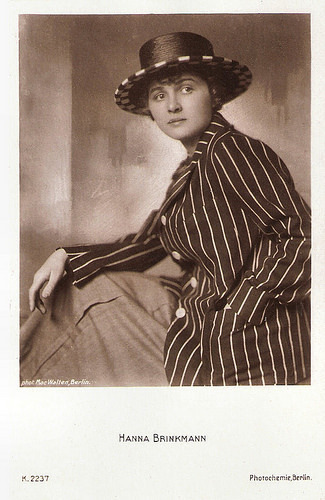
German postcard by Photochemie, no. K. 2237. Photo: Mac Walten, Berlin.
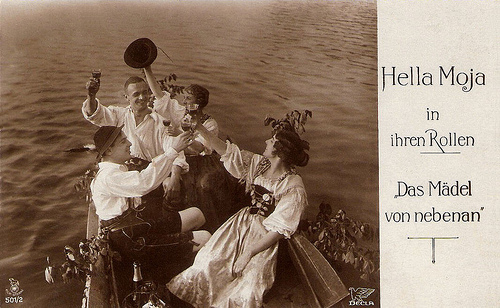
German postcard in the Film Sterne Series by Rotophot, nr. 501/2. Photo: Decla. Publicity still for Das Mädel von nebenan (Otto Rippert, 1917) with Hella Moja in the foreground of the boat and Hanne Brinkmann in the background.
The girl next-door
Hanne or Hanna Brinkmann was born as Johanna Marie Luise Elisabeth Brinkmann in Hanover, Germany, in 1895.
Under her birth name, she started her career in 1913 on stage at the Theater an der Wien in Vienna, Austria.
After the outbreak of the First World War, she returned to Germany. In Berlin, she made her film debut in Lache, Bajazzo!/Laugh Pagliacci! (Richard Oswald, 1914).
Soon she played bigger roles in films like Das Mädel von nebenan/The girl next-door (Otto Rippert, 1917) starring Hella Moja , and Baroneßchen auf Strafurlaub/Little Baroness on criminal holiday (Otto Rippert, 1918) with Hans Albers .
During the war, Brinkmann developed into a popular comedian and in 1918, she starred in her own short-lived 'Hanne' series, especially tailored to her talents. The director of the series was actor-director was Reinhold Schünzel , who had already acted with her in Die ledige Frau/The unmarried woman (Rudolf del Zopp, 1917).
Schünzel and Brinkmann married in 1919. A year later, she played a small part in her husband’s historical film Katharina die Große/Catherine the Great (Reinhold Schünzel, 1920) starring Lucie Höflich, Fritz Kortner and Fritz Delius. The film was an epic portrayal of the life of Catherine the Great of Russia, for which 4,000 extras and 500 horses were used.
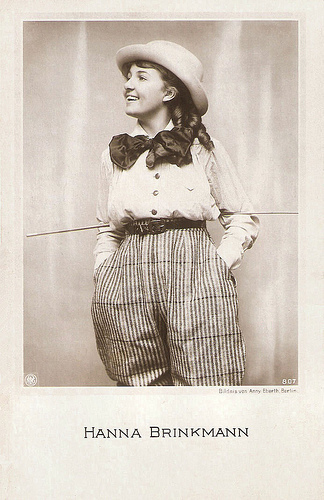
German postcard by NPG, no. 807. Photo: Anny Eberth, Berlin.
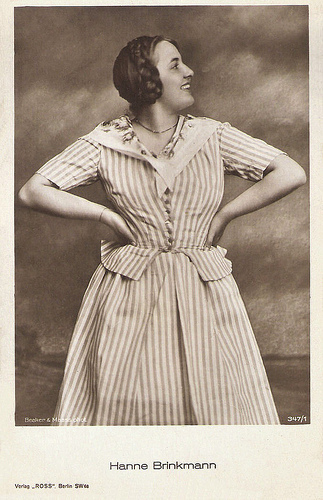
German postcard by Ross Verlag, Berlin, no. 357/1, 1919-1924. Photo: Becker & Maass, Berlin.
Mother and child
In the early 1920s, Hanne Brinkmann temporarily withdrew from show business to devote herself to the education of her daughter Anne Marie, who was born in 1922.
In 1924, Brinkmann returned to the screen and played a supporting part in the drama Mutter und Kind/Mother and Child (Carl Froelich, 1924) starring Henny Porten , Friedrich Kayßler and Wilhelm Dieterle . It was remade in 1934 as a sound film of the same title also starring Porten.
Brinkmann only played supporting parts from then on. One of her best known films was the historical drama Die Weber/The Weavers (Friedrich Zelnik a.k.a. Frederic Zelnik, 1927) starring Paul Wegener , an adaptation of the 1892 play by Gerhart Hauptmann based on a historical event. During the 1840s a group of Silesian weavers stage an uprising due to their concerns about the Industrial Revolution's impact of their lives.
In 1929 Brinkmann appeared opposite Georg Alexander in her last film, Was ist los mit Nanette?/What's up with Nanette? (Holger Madsen, 1929), and then retired from the cinema.
Later she divorced from Reinhold Schünzel , who emigrated in 1937 with their daughter to the US. Hanne Brinkmann died in 1984 in München (Munich), Germany.
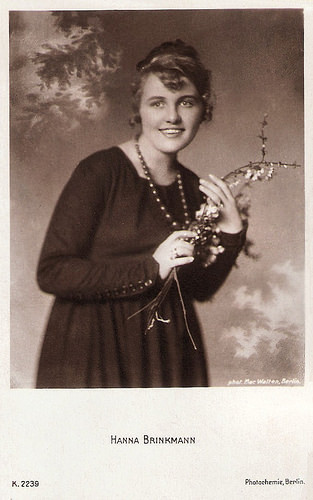
German postcard by Photochemie, Berlin, no. K 2239. Photo: Mac Walten, Berlin.
Sources: Thomas Staedeli (Cyranos), Filmportal.de, Wikipedia (German and English), and .

German postcard by Photochemie, no. K. 2237. Photo: Mac Walten, Berlin.

German postcard in the Film Sterne Series by Rotophot, nr. 501/2. Photo: Decla. Publicity still for Das Mädel von nebenan (Otto Rippert, 1917) with Hella Moja in the foreground of the boat and Hanne Brinkmann in the background.
The girl next-door
Hanne or Hanna Brinkmann was born as Johanna Marie Luise Elisabeth Brinkmann in Hanover, Germany, in 1895.
Under her birth name, she started her career in 1913 on stage at the Theater an der Wien in Vienna, Austria.
After the outbreak of the First World War, she returned to Germany. In Berlin, she made her film debut in Lache, Bajazzo!/Laugh Pagliacci! (Richard Oswald, 1914).
Soon she played bigger roles in films like Das Mädel von nebenan/The girl next-door (Otto Rippert, 1917) starring Hella Moja , and Baroneßchen auf Strafurlaub/Little Baroness on criminal holiday (Otto Rippert, 1918) with Hans Albers .
During the war, Brinkmann developed into a popular comedian and in 1918, she starred in her own short-lived 'Hanne' series, especially tailored to her talents. The director of the series was actor-director was Reinhold Schünzel , who had already acted with her in Die ledige Frau/The unmarried woman (Rudolf del Zopp, 1917).
Schünzel and Brinkmann married in 1919. A year later, she played a small part in her husband’s historical film Katharina die Große/Catherine the Great (Reinhold Schünzel, 1920) starring Lucie Höflich, Fritz Kortner and Fritz Delius. The film was an epic portrayal of the life of Catherine the Great of Russia, for which 4,000 extras and 500 horses were used.

German postcard by NPG, no. 807. Photo: Anny Eberth, Berlin.

German postcard by Ross Verlag, Berlin, no. 357/1, 1919-1924. Photo: Becker & Maass, Berlin.
Mother and child
In the early 1920s, Hanne Brinkmann temporarily withdrew from show business to devote herself to the education of her daughter Anne Marie, who was born in 1922.
In 1924, Brinkmann returned to the screen and played a supporting part in the drama Mutter und Kind/Mother and Child (Carl Froelich, 1924) starring Henny Porten , Friedrich Kayßler and Wilhelm Dieterle . It was remade in 1934 as a sound film of the same title also starring Porten.
Brinkmann only played supporting parts from then on. One of her best known films was the historical drama Die Weber/The Weavers (Friedrich Zelnik a.k.a. Frederic Zelnik, 1927) starring Paul Wegener , an adaptation of the 1892 play by Gerhart Hauptmann based on a historical event. During the 1840s a group of Silesian weavers stage an uprising due to their concerns about the Industrial Revolution's impact of their lives.
In 1929 Brinkmann appeared opposite Georg Alexander in her last film, Was ist los mit Nanette?/What's up with Nanette? (Holger Madsen, 1929), and then retired from the cinema.
Later she divorced from Reinhold Schünzel , who emigrated in 1937 with their daughter to the US. Hanne Brinkmann died in 1984 in München (Munich), Germany.

German postcard by Photochemie, Berlin, no. K 2239. Photo: Mac Walten, Berlin.
Sources: Thomas Staedeli (Cyranos), Filmportal.de, Wikipedia (German and English), and .
Published on October 31, 2014 00:00
Paul van Yperen's Blog
- Paul van Yperen's profile
- 13 followers
Paul van Yperen isn't a Goodreads Author
(yet),
but they
do have a blog,
so here are some recent posts imported from
their feed.



